In this article, we’ll explore all the best things to do in Santa Ana, El Salvador. We’ll look at the best activities, attractions and places to visit in El Salvador’s Santa Ana.
Santa Ana is the perfect place to set up camp for visitors coming to El Salvador. This old colonial city is ideally located near many attractions and activities in the country. Plus, it’s a vibrant city with tons to do and such a great vibe that draws a growing number of tourists each year.
El Salvador was often not a destination many visitors put on their bucketlist when visiting Central America, like neighboring Honduras, it had a bad reputation for crime and violence. But things are drastically changing and the country can finally breathe a sigh of relief as more people are coming here.
In fact, one of the things that touched us the most while visiting El Salvador was that the locals would often thank us for visiting. They would sometimes apologize for how small their country is but would reassure us that there are still plenty of things to do here. They would then proceed to give us all the best recommendations of things to do, places to go and unmissable adventures to have.
To be honest, El Salvador quickly became one of our favorite countries to visit in Central America. What the country lacks in size, it makes up for in the generosity of its people and the beauty of its landscapes.
Santa Ana, being the second-largest city in the country, boasts a lot of the best things to do in El Salvador. In this article, we want to share all the best things to do in and around Santa Ana. You’ll find the best activities, places to go and things to do, as well as some restaurant recommendations and places to stay.
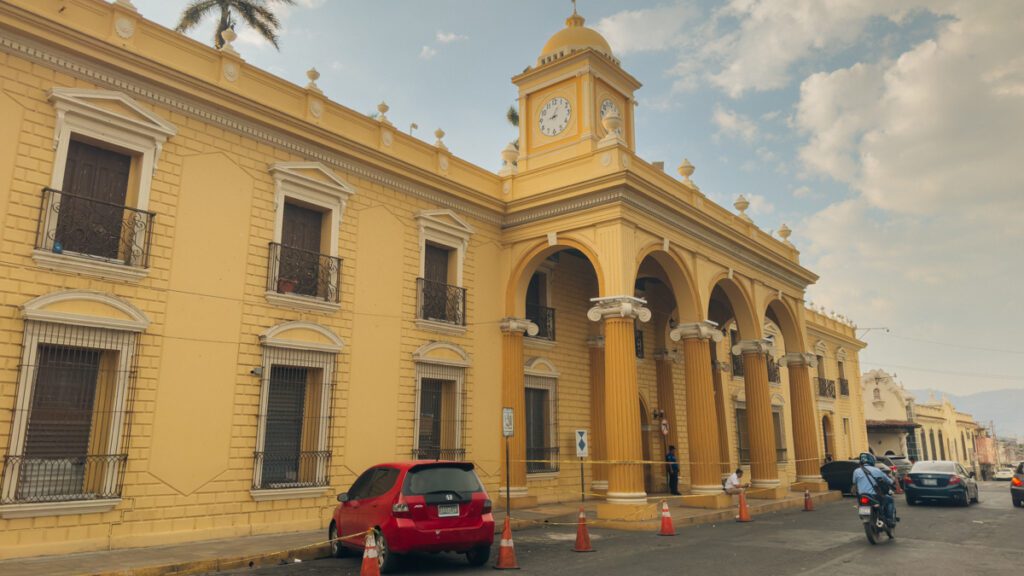
This article may contain affiliate/compensated links. For more information, please see our disclaimer here. We take all the efforts necessary to ensure the information included in this post is accurate, correct and current, sometimes, things just change! Travel information like opening hours, business operations and prices may change. If you find anything in this post that is incorrect or outdated, please let me know in the comments so I can update it for other readers. Cheers!
We love helping you plan amazing trips. If you need any of these services, consider booking them through our affiliate links. Without costing you anything extra, you will be helping support us so we can continue to write these blogs for you.
We thank you again for your continued support.
🏠 Find the perfect place to stay with Booking.com
✈️ Get the cheapest flights with Skyscanner
🚣 Book your favorite activities with Viator
💻 Make sure you have everything you need for your epic trip by checking our store on Amazon
Table of Contents
A little bit about El Salvador’s Santa Ana
Before getting to Santa Ana, it’s important you know a bit about the city. We already mentioned that it was the second-largest city in El Salvador, right after the capital of San Salvador. It’s located in the western highlands of the country, surrounded by mountains and volcanic landscapes. It’s a city known for its rich history, cultural heritage, and natural beauty.
The history of the city dates back to pre-Columbian times when it was inhabited by indigenous peoples including the Pipil and Lenca.
Led by Pedro de Alvarado, the Spanish conquistadors arrived in the area in the early 16th century. They initially encountered resistance from the indigenous populations, but eventually, they established control over the territory. And it was in February 1569, that the city of Santa Ana was established, named after Sainte Anne, the mother of the Virgin Mary.
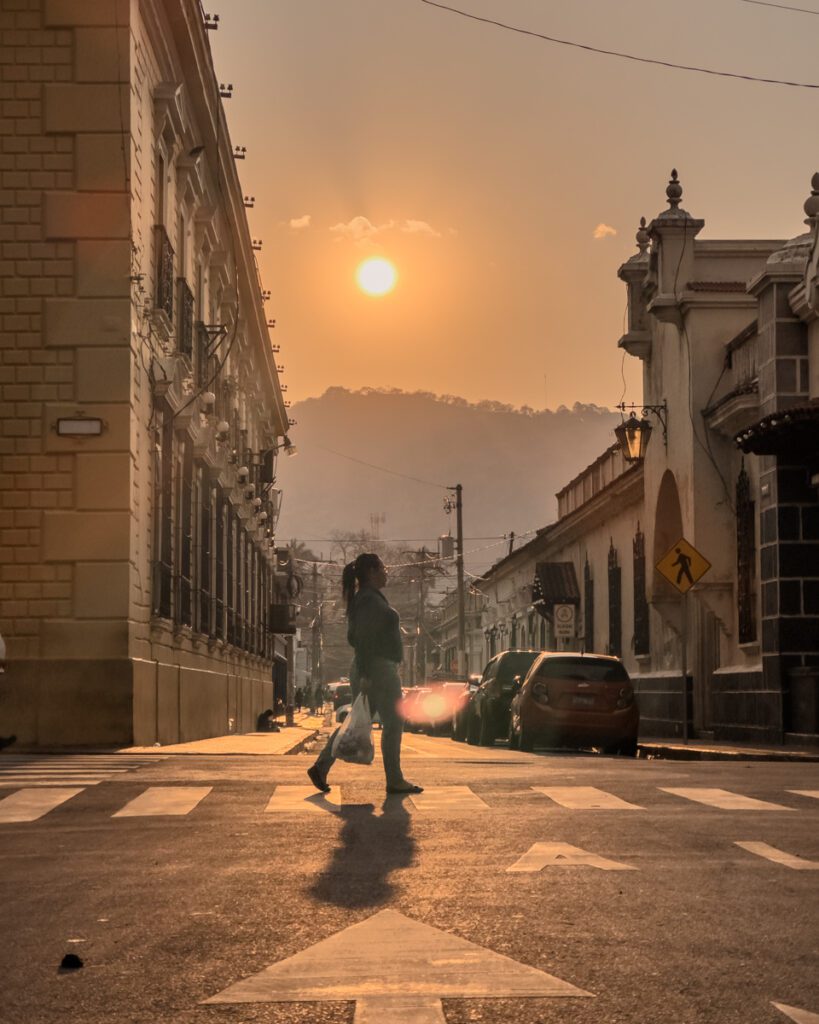
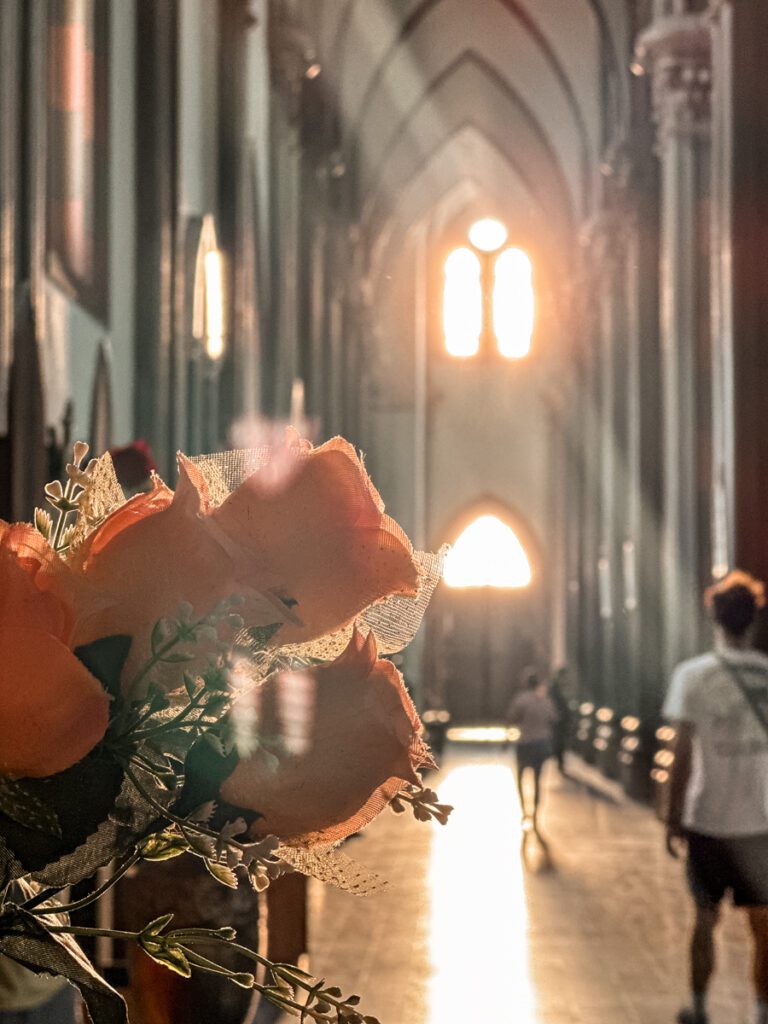
During the colonial period, Santa Ana became an important administrative and economic center. The city’s growth was supported by agriculture, including the cultivation of indigo, which was a valuable commodity.
Today, it’s still one of the country’s important hubs, though for many other different reasons. The economy of Santa Ana is diverse and includes trade and services, as well as agriculture of coffee, sugarcane, and other crops in the nearby regions.
Santa Ana is a city that blends its historical charm with natural beauty, making it a compelling destination for travelers. Visitors can explore the cultural heritage, enjoy outdoor activities, and experience the warmth of the local community.
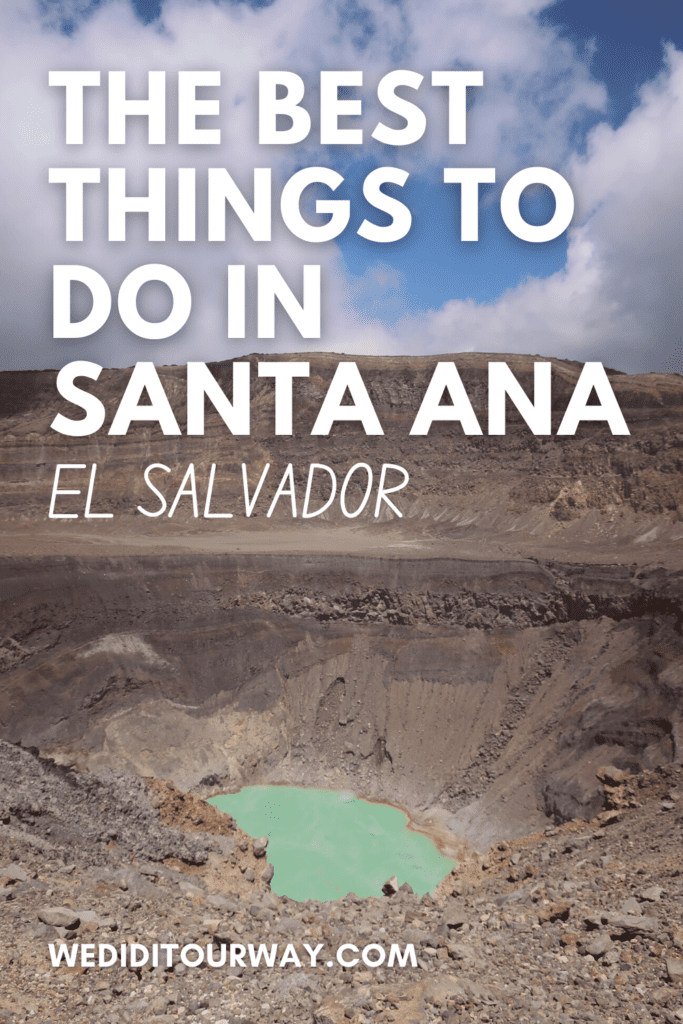
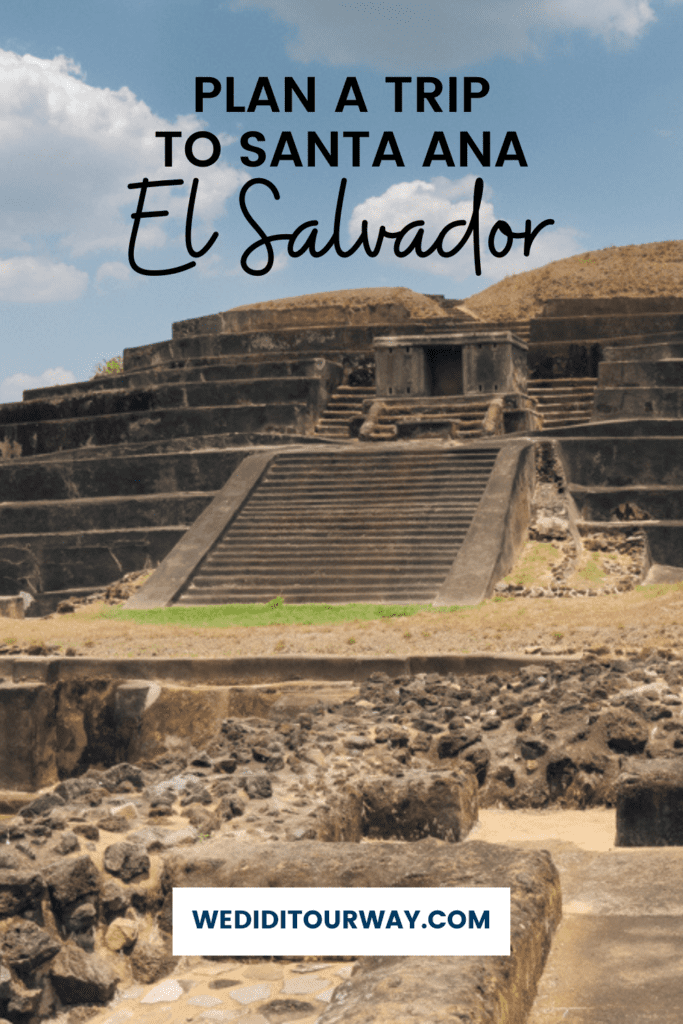
13 amazing things to do in Santa Ana, El Salvador
Santa Ana is a great place to set up camp if you plan on exploring some of the best things to do in El Salvador. Its location is great for enjoying the colonial vibes of the city and taking in its rich culture, and it’s also close to a bunch of outdoor activities, as well as some historic and archeological sites.
Regardless of what you’re into, what your budget is and how long you’re staying in Santa Ana, you’re bound to find something in this list that is worth your while! And as always, don’t take this article as a checklist. Take the time to immerse yourself in the culture and the vibe of the city. Enjoy your time here, and do what feels right for you.
1. Check out the Cathedral, the top attraction in Santa Ana, El Salvador
The Santa Ana Cathedral, or Catedral de Santa Ana in Spanish, has a rich history. It was constructed in the late 18th century and since then, has been a symbol of faith and endurance for the people of Santa Ana.
Its construction was finished in 1751, and it’s a prime example of Spanish colonial architecture in El Salvador. Its design reflects the Baroque architectural style, characterized by ornate detailing, grand facades, and decorative elements. You can’t stand indifferent in front of this beautiful church! And even inside, you can admire many different religious artwork, statues, and ornate altars.
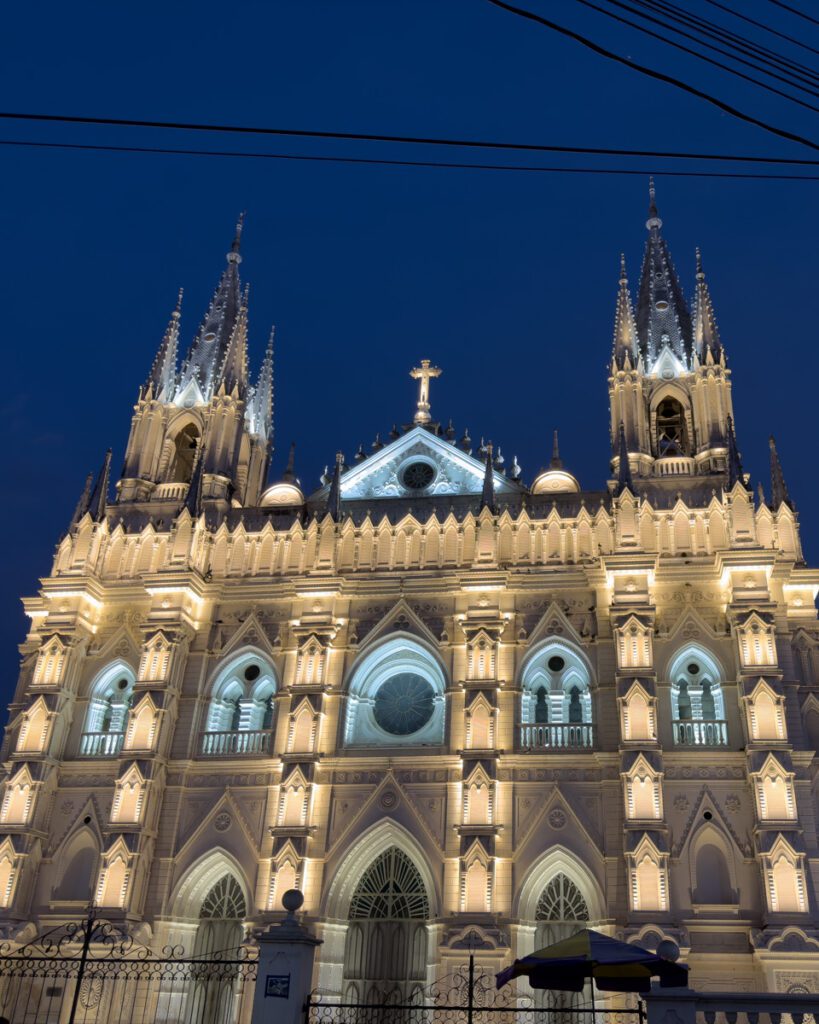
Located in Plaza Libertad, the main square in the city, this attraction in Santa Ana is surrounded by other important buildings like the National Theater. Like most important squares in Central America, the Plaza Libertad and the Cathedral of Sanata are both focal points for civic and cultural events. Don’t be surprised if you come upon a gathering here while you’re in the city. For example, there is the Feast of Saint Anne, an annual celebration in Santa Ana. During this time, the cathedral becomes a focal point for religious processions and festivities. Pilgrims and locals gather to honor the patron saint, the Mother of the Virgin Mary, and the patron of mothers and grandmothers.
During the earthquake of 1773, many of the colonial-era buildings suffered significant damage, including the Cathedral of Santa Ana. However, it was reconstructed and repaired, and since, there have been many preservation efforts to ensure its historical integrity.
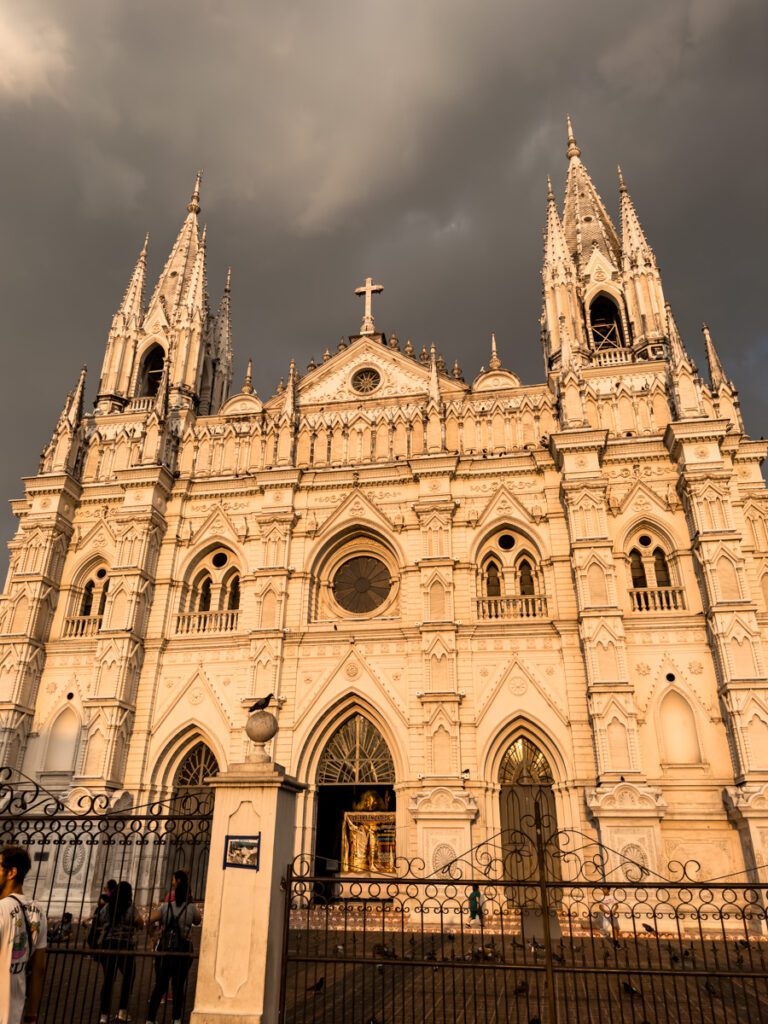
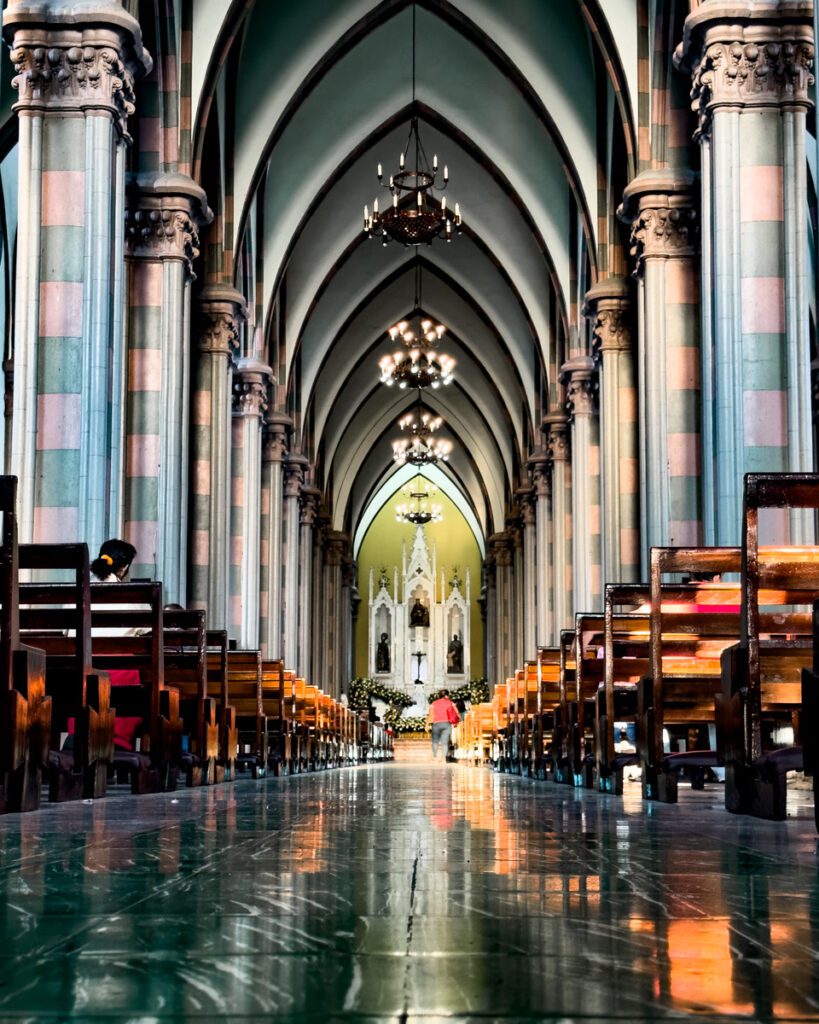
You’ll notice that the church is always busy, children are playing in the front section, chasing the birds. People inside worshiping. More people are outside, taking pictures or admiring the beauty of the cathedral. It’s evident, not only by its imposing beauty and stature, that this cathedral is appreciated by all who lay eyes on it.
Whether you’re religious or not, you will surely be drawn to the beauty of this cathedral, and quickly understand why it’s one of the top attractions in Santa Ana.
2. Hike the Ilamatepec Volcano, one of the top things to do in Santa Ana
If you haven’t had a chance to hike the volcanoes of Guatemala or didn’t feel up for it, don’t worry, because there’s always Llamatepec Volcano, located near Santa Ana. The Santa Ana Volcano is located in the Cerro Verde National Park.
Luckily, hiking Santa Ana Volcano is not as hard, or long as some of the other volcano hikes in Central America. And since it’s the highest volcano in El Salvador, you get amazing views and bragging rights! It stands tall at an elevation of approximately 2,381 meters (7,812 feet) above sea level.
Although Santa Ana is an active volcano, its most recent eruption happened close to 20 years ago, in 2005. It has erupted numerous times throughout history with the first time being about 100 years ago. At the summit of Santa Ana, there is a crater with a turquoise-green sulfurous lake in it.
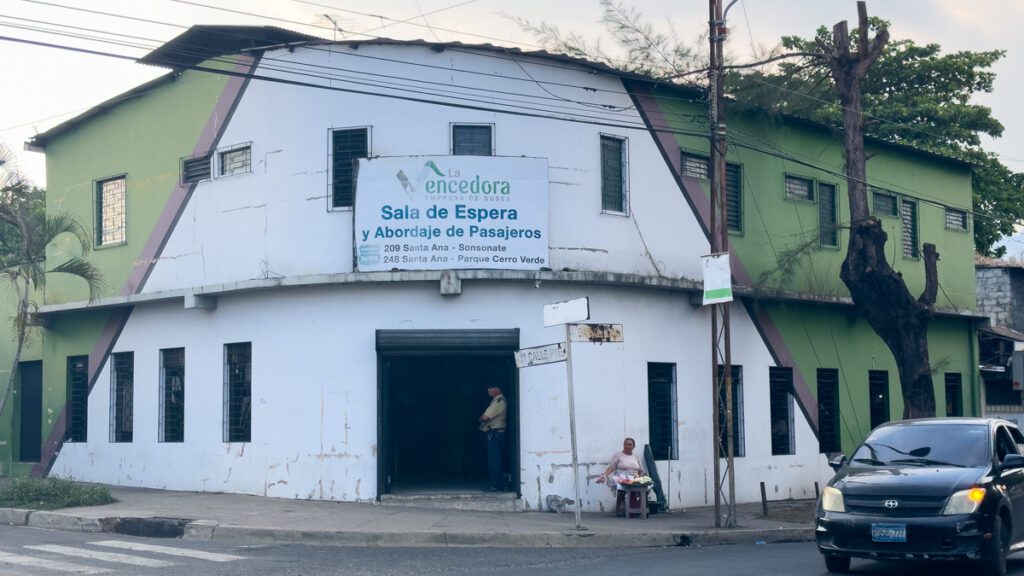
The easiest way to get to Santa Ana Volcano is by taking bus #248 there. All you have to do is go to the bus station located here. The bus leaves at 7:50 am (but we recommend arriving earlier to buy your tickets as during the busy season, there can be crowds. The cost of the ticket is $0.70 USD and the ride takes about one hour forty to 2 hours. Expect to arrive around 9:30 am.
Once you get there, you’ll have to make your way to the trailhead. As you approach it, you’ll find some local guides there. You will be asked to pay $3 USD pp for the guide and another $6 USD for the entrance to the park. You’ll pay the entrance fee a little later when you get to the ranger’s station.
Do you need a guide to do the Santa Ana volcano hike? No…
Will the guides there tell you it’s mandatory? Yes, but they’re trying to make a living… Regardless of if it’s scammy or not.
If you insist and wait long enough the guides will get tired and leave you to do the hike alone. We saw many people do this while we hiked. They didn’t really hold the rest of us up. And the trail is well marked, so there’s no worry of getting lost. However, considering the dark past of the country and its ties to the drug trade, we encourage you to pay the guides. This is an honest way for them to make a living, and probably, the $3 you’ll pay is worth a lot more to them than it is to you.
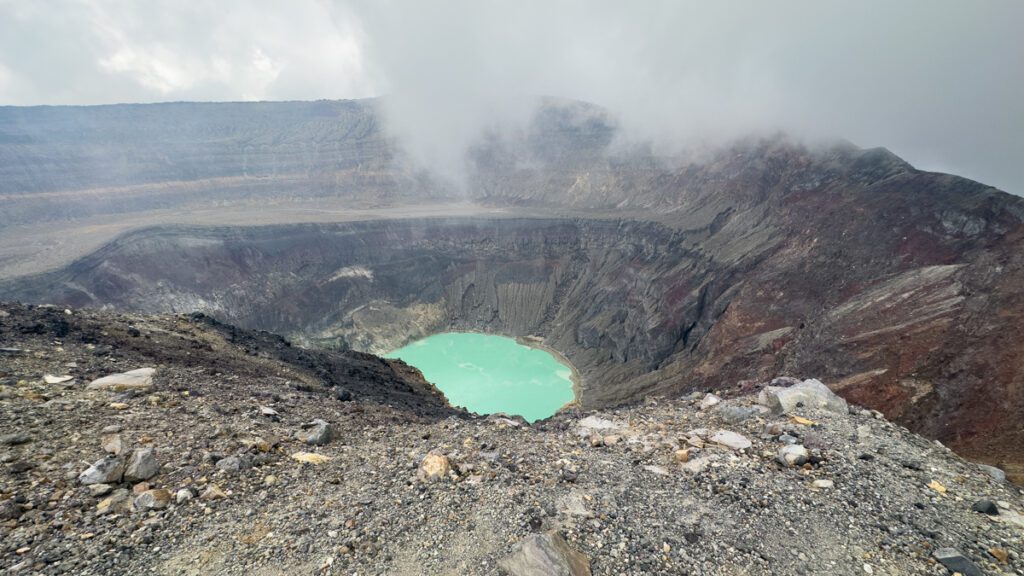
The hike itself is not very long or difficult. It took about 3:30 to complete it, including a good 30 minutes at the summit. We weren’t blessed with views when we got up there. It was very cloudy and fog kept coming in. However, on sunny days, it’s said that you can see nearby Lake Coatepeque as well as all the way to the Pacific Ocean.
The bus to Santa Ana leaves at 1:25 pm. We had a good 20 minutes at the bottom before the bus arrived, so there wasn’t much of a rush for us coming down. It’s important to be timely, as the bus is not very frequent. It also doesn’t drop you off where you first hoped for.
If you want to do the hike more sustainably, we recommend you follow the ‘Leave no trace’ principles, taking all your trash back with you. Also, make sure you stay on the trails, so as to not disrupt the flora.
If you want to go on a little challenge, hike a volcano, or just get out of Santa Ana for a few hours, this volcano hike is definitely one of the best things to do in Santa Ana.
Purchase tickets here: Search for Sala de Espera y Abordaje “LA VENCEDORA”. The location: https://maps.app.goo.gl/CdoscGbPXXRUEkC39
Difficulty level: The Santa Ana Volcano hike is considered to be a moderately challenging hike. There are some steep ascents and descents.
How long is the hike: About 3-4 hours depending on your pace, fitness level and weather conditions
Cost to hike Santa Ana Volcano: $3 USD for the guide. $6 USD as an entrance fee
Amenities: There are bathroons and sinks at the Ranger’s Station. None on the trail. There is an ice cream vendor at the top of the volcano.
What to wear: Hiking shoes. Raincoat. moisture-wicking clothing. Pants. Bring a light jacket or windbreaker. The weather changes quite quickly on the volcano and the summit is much cooler than the bottom. Also, some parts of the hike are on the side of the mountain, where you don’t have shelter from the elements.
What to pack: Hat. Water. Snacks. Sunscreen. Mosquito repellent, if you are sensitive. A small bag to bring your trash back with you.
3. Explore Coatepeque Lake, one of the best things to do near Santa Ana
Coatepeque Lake is a crater lake located about a 40-minute drive away from Santa Ana. You can go here for a day trip, or you can choose to spend a night or two at the Lake. The views here are what get people coming back. It’s a popular destination for locals and tourists alike.
Although there is a bus that goes from Santa Ana to Lake Coatepeque, it doesn’t pass very often. We highly recommend you take an Uber to get there. It’s much faster and more convenient. And it’s only about $15 USD for the ride. You can even arrange for the driver to pick you back up when you’d like to leave.
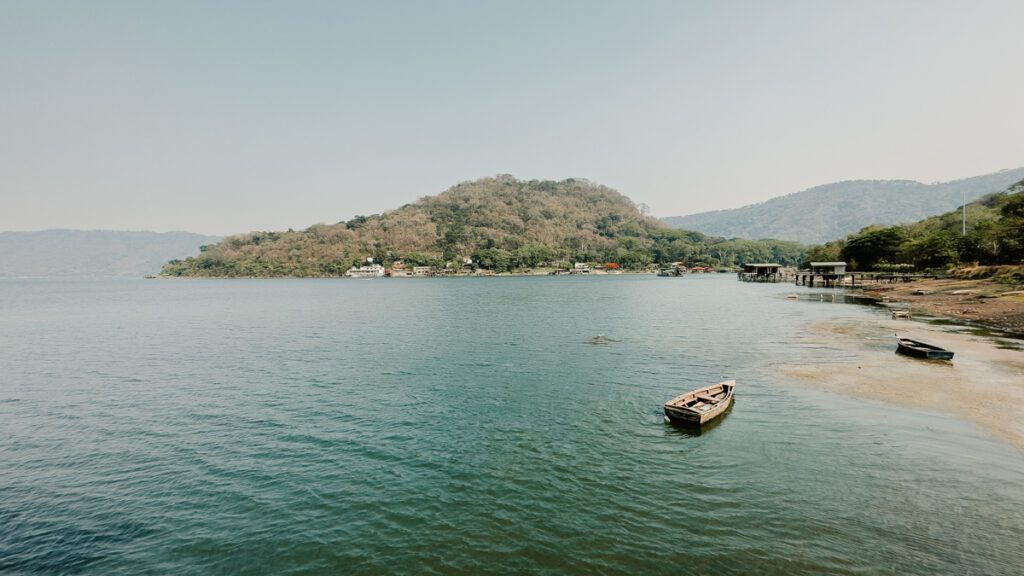
We had the pleasure of staying at Lake Coatepeque for a few days. We stayed in a family-run hotel called Equinnoccio Hotel. They have a restaurant on location, and their rooms are comfortable and luxurious. If you don’t want to stay the night, you can also opt for a day pass, and enjoy their pool, bar and many activities on the water.
In fact, the best thing to do in Lake Coatepeque is to enjoy life on the lake. Many accommodations have hammocks and views of the lake, while others offer you the possibility to enjoy paddleboarding, canoeing or kayaking, boating, jet skis and much more. The water is also good for swimming, but this will depend greatly on the season. Hopefully, you will be luckier than we were, and the weather, and lake conditions will be nice.
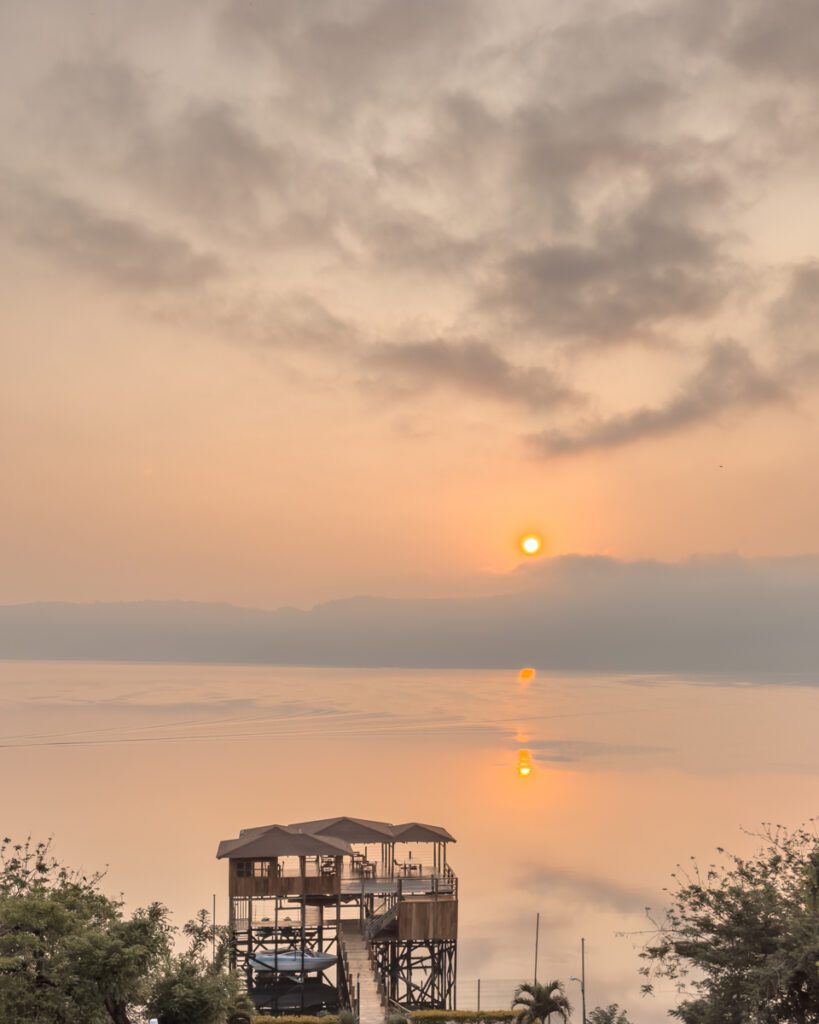
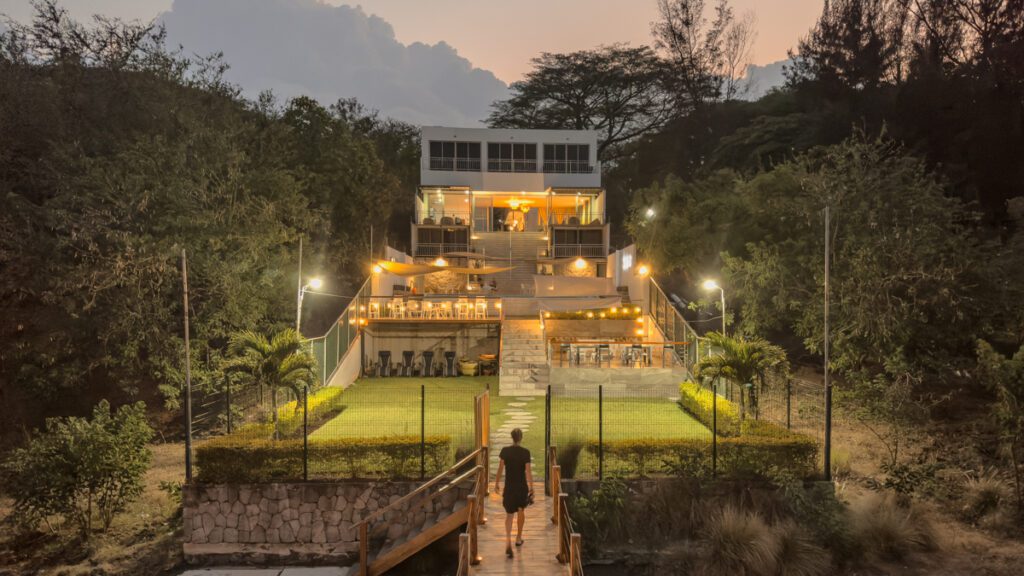
We were there in mid-April, and the weather was a mix of sunny and rainy (the wet season was about to start). We still had plenty of sun, but with bouts of heavy rain. The water, however, was not suitable for swimming. There was a thick layer of algae that had formed. Not only did it smell bad, but it was unthinkable to jump in. If you want to have a higher chance of enjoying the Lake, we recommend going from November to May.
There are quite a few places to stay around the Lake, although many properties have been bought by prominent Salvadorians. For those traveling on a budget, there is the Captain Morgan Hostel which has great reviews. Our friends stayed here and really enjoyed it. If you want to splurge a bit, you can stay at Equinnoccio Hotel, or others located on the lake.
Coatepeque Lake is one of the largest crater lakes in the country, and a day trip here from Santa Ana, or even a full weekend getaway, is probably one of the best things you can do in Santa Ana.
4. Experience the Local Markets, a must-do in El Salvador’s Santa Ana
One of the best ways to experience local culture is to walk around the local markets. Plus, it’s the best place to buy fresh produce, perfect for cooking at home, or to take on treks.
Walking around the city, you’ll notice there are plenty of markets around. Some of them sell clothes and knick-knacks, while others sell fruit and produce. Either way, it’s a great way to see locals interacting, and to encourage the local economy, if you’re looking to buy some things.
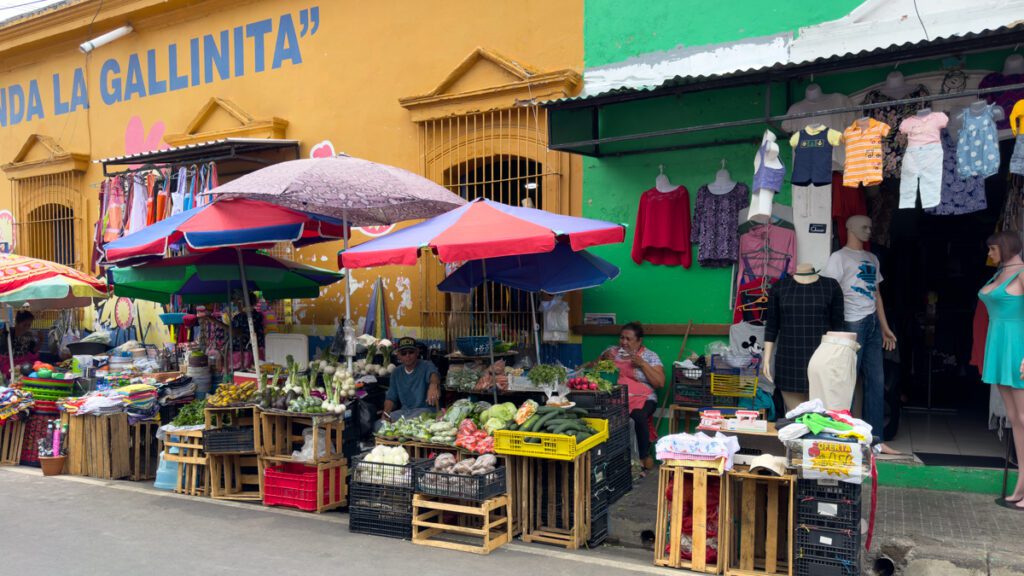
Most of the markets are near bus stations, but there is also the Central market of Santa Ana which is really interesting to discover. It’s located off one of the main streets leading to the main Plaza, where you find the Santa Ana Cathedral. You can find the location here. Although it says it’s temporarily closed, most of the vendors are actually outside, so no need to walk in.
The best time to visit the markets is in the morning when the markets are at their liveliest and the fresh produce is abundant. Just be prepared for a sensory overload experience – the sights, the sounds, the smells all around. Also, be mindful of your belongings because these are crowded areas, and petty crime is possible.
5. Wander around the Historic Downtown, a great activity to do in Santa Ana
The main plaza, Plaza de Libertad, is a good place to start discovering the Historic Center of Santa Ana. You can zigzag through the streets here, admiring the beautiful colonial architecture.
The streets here are lined with local shops, little restaurants, street vendors and people, walking around. This is where you see the vibrant city come to life. At pretty much all hours of the day, and night, you will find people enjoying the best of the city. Calle Real is one of the city’s main streets with historic charm that is worth spending time exploring.
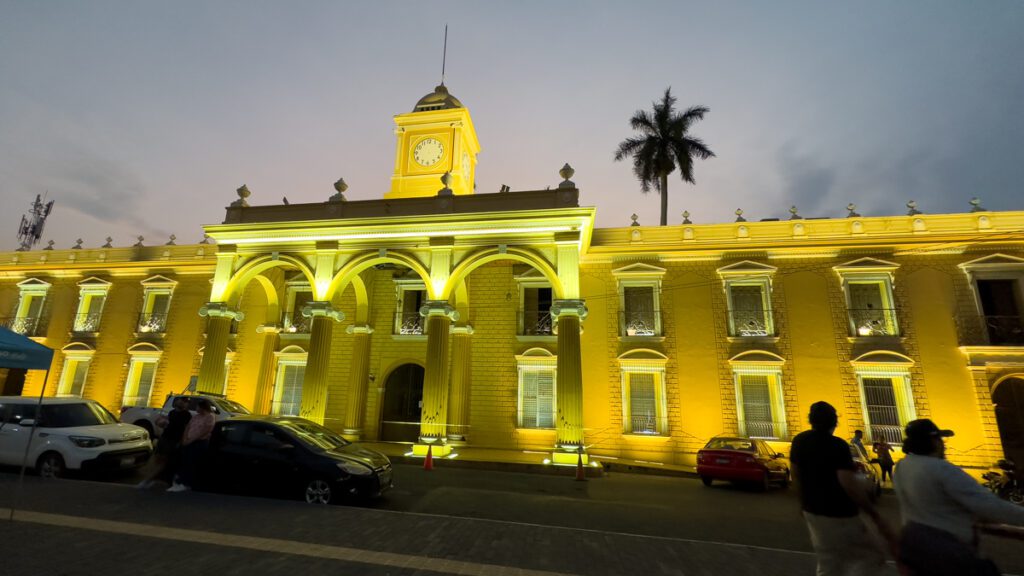
Plaza Libertad is an interesting attraction in Santa Ana itself. It’s surrounded by important buildings and serves as a gathering place for locals and visitors alike. Its most notable buildings are the Santa Ana Cathedral, the National Palace, the Teatro de Santa Ana (their main theater in the city), as well as the Museo Regional de Occidente (the Museum of Western El Salvador), which showcases the history and culture of the region. Here you can find exhibits on pre-Columbian history, the colonial era, and contemporary art.
Near the main cathedral, you can see a small church in the distance, the church of San Lorenzo. Take the time to walk in that direction, not only to check out the church but to look around the city. Near the church, there’s actually a small soccer field called Canchita El Tamarindo. If you really want to immerse yourself in local culture, take the time to check out a kid’s soccer game there. It’s tons of fun.
You can easily spend half a day walking around the historic city center. Take the time to walk into shops, try some local coffee, or just sit in the main square, Plaza Libertad, and watch people living their daily lives. It’s truly a great experience.
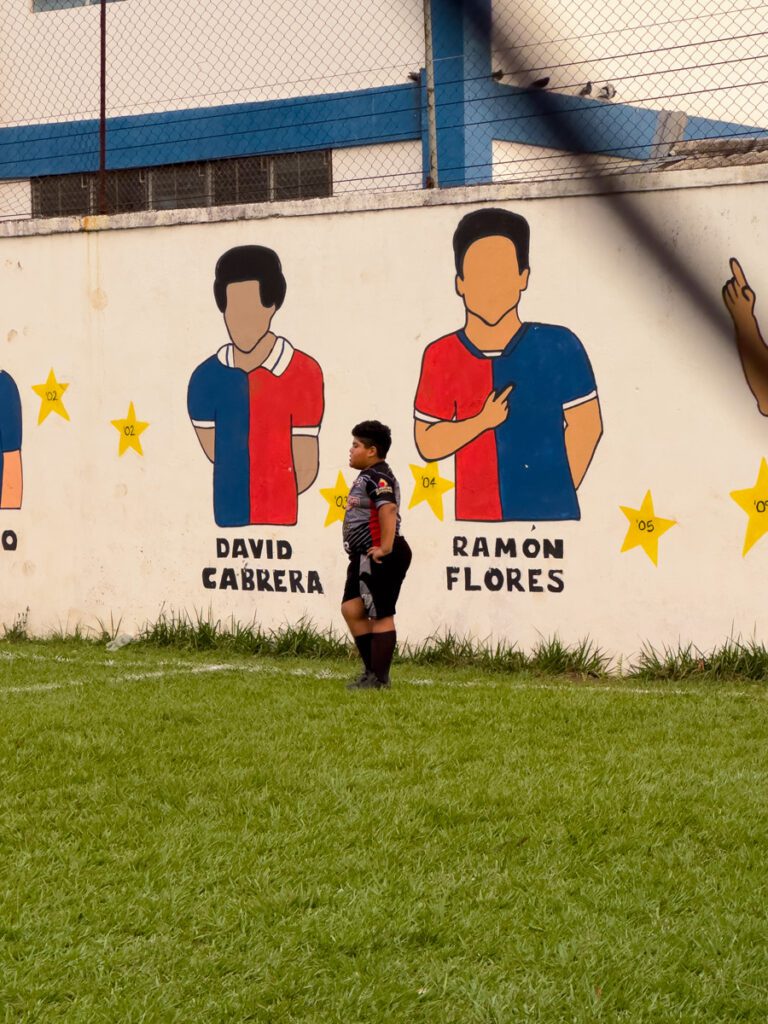
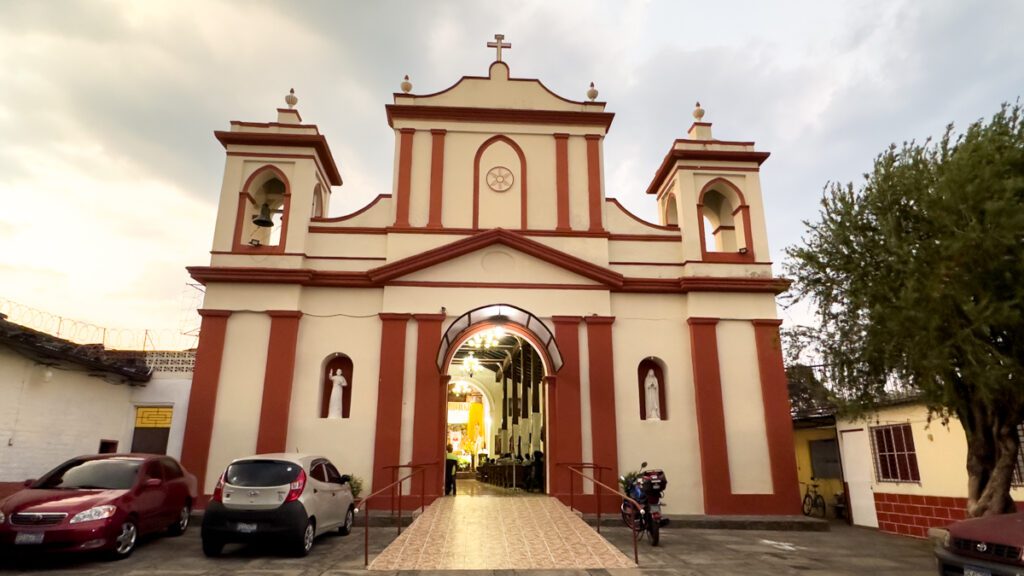
6. Check out the Santa Ana National Theatre, a great attraction in Santa Ana
You don’t have to walk too far from the main plaza to enjoy this activity in Santa Ana. The National Theater is one of the main attractions in Santa Ana. It’s a great place to discover the arts and culture of this great city.
Depending on when you’re in town, you can check out one of the shows taking place at the Teatro National de Santa Ana. They have the schedule available online, so make sure you buy your tickets ahead of time if you know when you’ll be in town.
Beyond the shows that take place inside the theater, the building itself is quite beautiful on the outside as well. If you don’t have a chance to make it to a show, at least you can admire the beauty of this colonial-era building.
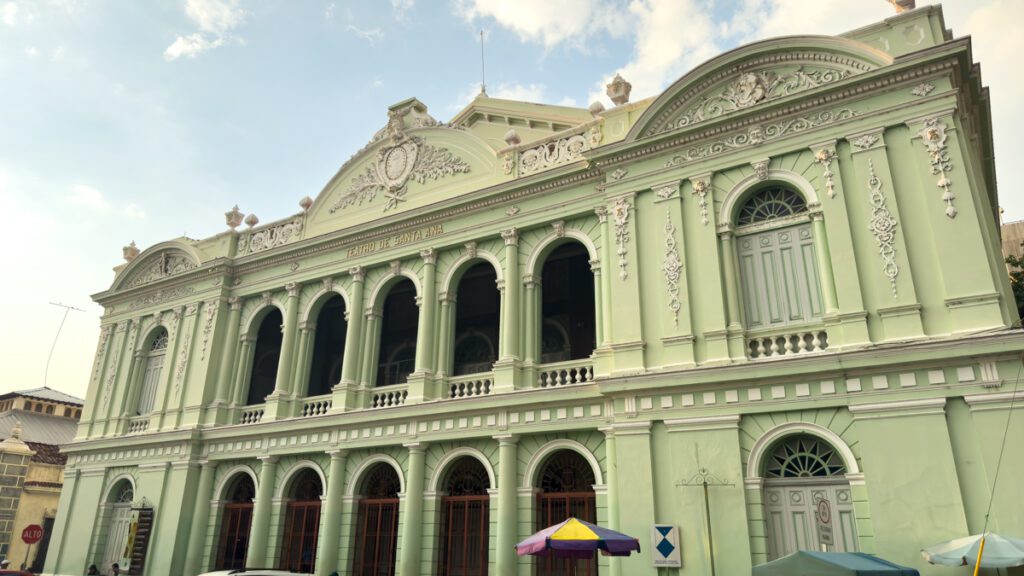
7. Visit the Mariano Mendez School of Fine Arts, a Santa Ana attraction to take you back in time
We’re really disappointed we only found out about the proper way to visit this beautiful school on our last day in Santa Ana. But if you have some time in the city, these ruins are well worth visiting, especially for those who love photography like us.
The Mario Mendez School of Fine Arts is no longer a school. But back in its heydays, it was an institution known for its liberal and progressive ideas. This was also one of the first schools in the country to accept female students.
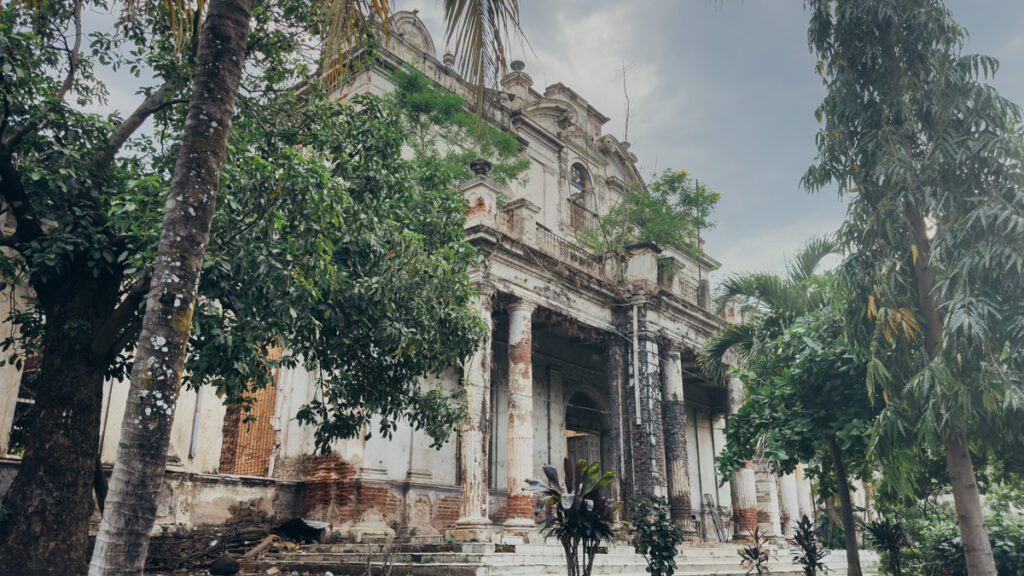
Unfortunately, the school was destroyed during the Civil War. All that remains today are these ruins. Although it had a really sad fate, the school was an important part of El Salvador’s history. And the ruins themselves are really beautiful.
We tried to get in by talking to the security guards who stood by the gates, but they wouldn’t budge. We were told that they would get in trouble as there were security cameras all around.
If you want to get in you need to get a permit from the tourist office which is located south of Parque Libertad. It’s in the same building as the library. Once you get the permit, you can go to the Mario Mendez School of Fine Arts, show the permit to the guard, and then, you can walk around and revel in the beauty of this old building.
8. Explore Joya de Cerén Archaeological Site, one of the top attractions around Santa Ana
Often referred to as the “Pompeii of the Americas.”, Joya de Cerén is a UNESCO World Heritage site located near Santa Ana. What makes this place so special and unique is that this ancient village is preserved in volcanic ash, much like Pompeii. It gives us a glimpse into daily life during the Mayan civilization.
The site was discovered back in 1976 during routine construction work. Excavations revealed a remarkably well-preserved ancient village that had been buried under volcanic ash. Since then, many efforts have been made to excavate the area and preserve it.
The volcano that caused the town’s destruction (but also its preservation), is the eruption of the nearby Loma Caldera volcano. However, through studies, it was understood that the village was occupied from approximately AD 600 to AD 900. This was during the Late Classic period of Mesoamerican civilization.
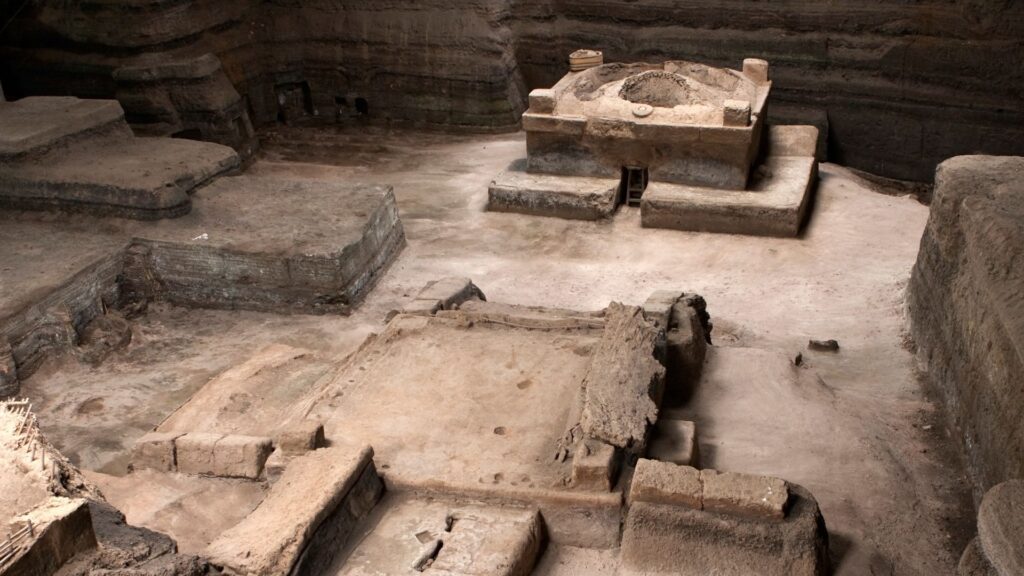
As you explore the site, you can see what was excavated: houses, kitchens, workshops, religious structures, and agricultural fields. There are also pottery, stone tools, grinding stones, and personal items that were found. A truly fascinating glimpse into what life was like back then.
In 1993, Joya de Cerén was designated as a UNESCO World Heritage Site. It was recognized for its exceptional archaeological value and contribution to understanding ancient societies. Today, you can visit the museum and interpretation center which give you a lot more context into the artifacts that were found during excavations. You can also go on a guided tour where your guide will give you a lot more historical and cultural insights.
From Santa Ana, it’s about a 45-60 min drive to Joya de Cerén. You can either take an Uber (which will set you back around $20 USD, or take bus 201 from Santa Ana (42km) to the turn-off for Opico, and then bus 108 (10 minutes, $0.50 USD) from outside the gas station at Sitio del Niño. Get off after crossing the bridge over the Río Sucio. There are signs to the ruins.
This archeological site is one of the most impressive in the country. If you’re looking for something interesting to do while you’re in Santa Ana, or even San Salvador, a stop at Joya de Cerén is well worth it.
Official site
Opening hours: Tuesday to Sunday, from 9 am to 4 pm
Entrance fee: Salvadorans $1.00. Central Americans $3.00. Resident foreigners $7.00. Non-residents $10.00 (Prices are in USD)
9. Visit Tazumal Archaeological Site, an interesting thing to do in Santa Ana
If you don’t have a chance to visit Joya de Cerén but still want to see an archeological site, there’s Tazumal which is located about 15-20 minutes away from Santa Ana. We’ll warn you, however, that if you’ve been to Tikal in Guatemala or even the different archeological sites in Belize or Mexico, this one will not impress you.
However, in the defense of these ruins, since they are located in the heart of Chalchuapa town, excavations have been restricted. It is believed that many other structures are around, but have not been unearthed yet. Within the area of the park, there are still many different Mayan structures to see like ancient ruins, pyramids and ceremonial structures.
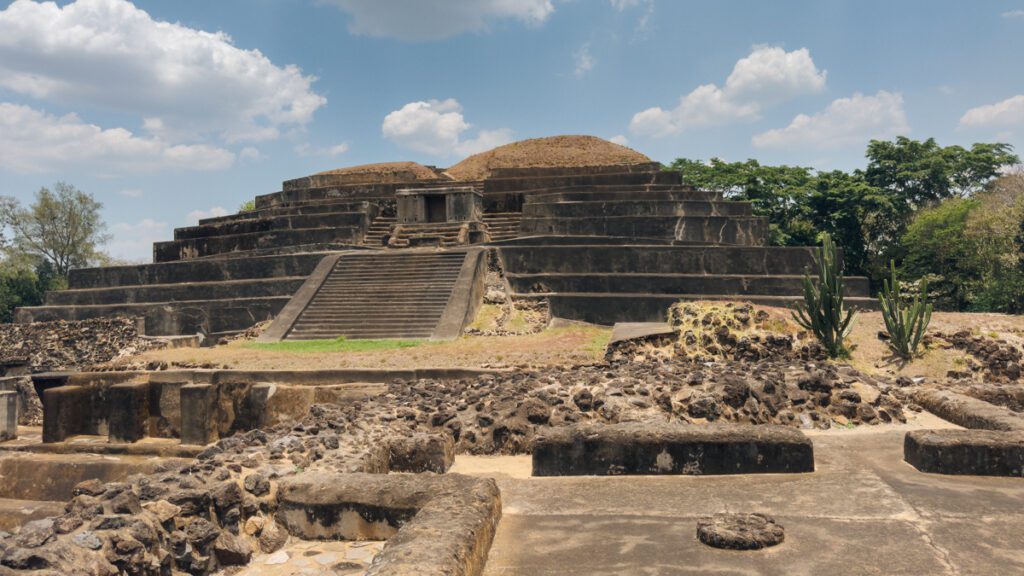
Chalchuapa, the town where the Tazumal ruins are located, is one of the oldest prolonged settlement places in El Salvador. The city has its own culture that draws influences from others like Mayan, Teotihuacan, Toltec, and many other groups. As for the Tazumal ruins, the peak of its ruling settlement was during the Classic Period (200 BC to 900 AD).
It will take you about 1 hour to visit the ruins if you go without a guide. We recommend going early as it does get quite hot during the day, and there are no shaded areas here. There is also a small visitor center where they feature a few artifacts found at this site and others. This collection is also fairly limited.
There are 2 ways you can get to the Tazumal Ruins from Santa Ana. An Uber ride is the fastest way to do it, and it will set you back about $10 USD. You can also take a bus #218 to Tazumal. Take the bus between Avenida 10a and 8a on Calle 9a poniente. For a faster ride, try to get the bus that says ‘Directo’ it will shave about 20 minutes off the trip.
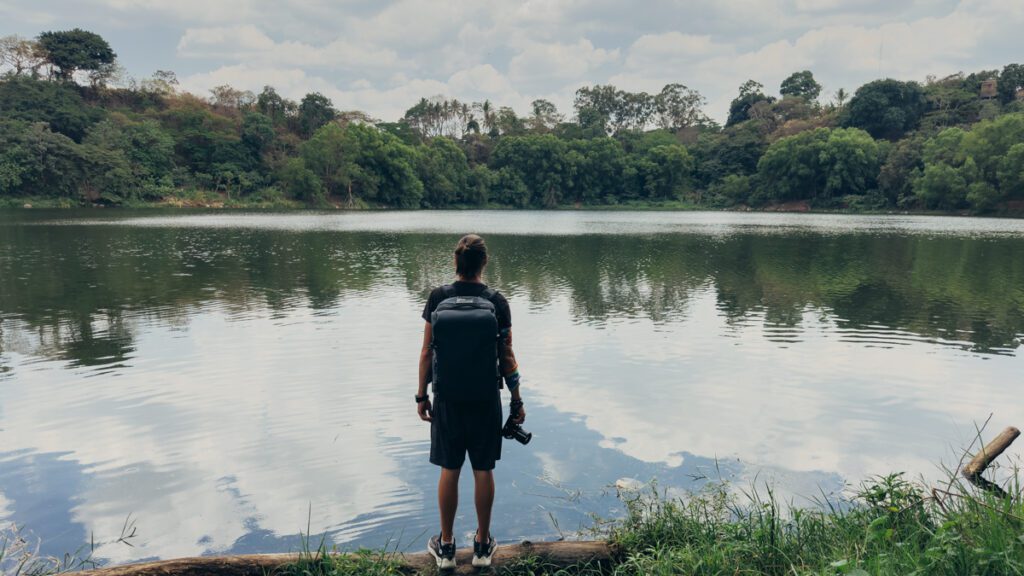
If you have a chance, walk to the nearby Laguna Cuzcachapa. You can walk around the small lake, and enjoy the beautiful views here. You’ll spot some motmots and quetzals in the trees. You’ll also likely meet a few locals who come to have lunch or hang out around the lake. They’ll enthusiastically greet you, ask you a ton of questions and give you some recommendations of things to do in town and around the country.
Official site
Opening hours: Tuesday to Sunday, from 9 am to 4 pm
Entrance fee: Salvadorans $1.00. Central Americans and Resident Foreigners $3.00. Non-residents $5.00. Prices are in USD
10. Relax in thermal springs near Santa Ana, one of the best attractions near Santa Ana
We wish we had known about these thermal springs while we were in Santa Ana. We only found out about them while we were in Juayua, on the Ruta de las Flores. If you want a day of rest and relaxation, this is the perfect thing to do in Santa Ana.
There are 2 famous hot springs near Santa Ana. Although they are similar, they also offer quite a different experience.
The first one, Santa Teresa hot springs, or Termales Santa Teresa, are more popular than the next ones. These are located in Ahuachapan, about 1 hour from Santa Ana. The hot water comes from the Santa Teresa fumarole or hot water geyser, which is the largest in Central America. Here, you will find swimming pools and the blue pond where you can bathe. They also offer massages on location. They have lockers and towels for rent. But we recommend bringing your own towels to come. These springs are quite popular, so we recommend coming early to beat the crowds. If not, it will be harder to relax.
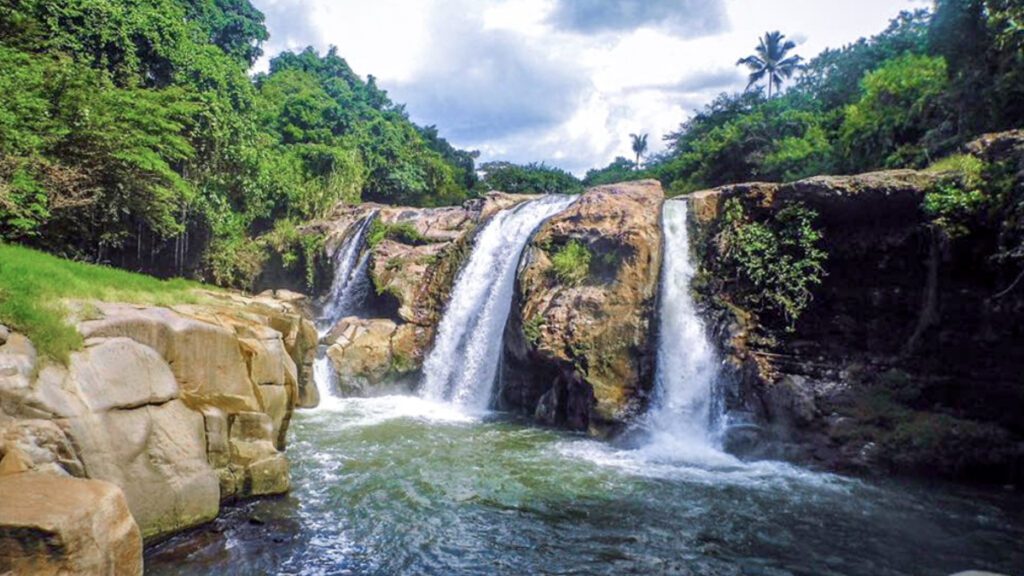
The next springs came much more recommended by locals and they are much cheaper than the latter. The Salto de Malacatiupan, located in Atiquizaya, is a spectacular waterfall and a hot spring all rolled into one. The water here reaches around 36 Celsius (or 97 Fahrenheit). On weekdays, you’ll likely have this place to yourself. It’s a much more natural experience than the Santa Teresa springs.
To get to Salto de Malacatiupan from Santa Ana, you have to take bus 210 or 214 from the Francisco Lara Pineda Bus Terminal near the market. Buses leave regularly throughout the day, but as usual, you may have to wait until there are enough people on board to leave. The drive to Atiquizaya should take around 40 minutes. From the drop off point, you’ll either need to take a tuk-tuk or taxi to get to these springs (or walk for 1 hour).
In both cases, we recommend bringing towels, water and some snacks with you. The time to get to and from the springs can be long (as you may have to walk or take a tuk-tuk from the bus station) and the heat from the water is dehydrating.
11. Take a Coffee Tour, one of the best things to do from Santa Ana
Like most countries in Central America, the coffee tours are an excellent way for coffee drinkers and lovers to get a feel of the authentic culture while learning more about the trade, and supporting local producers. El Salvador is a great place to get your fill! (Pun totally intended!)
You can organize a tour of a coffee plantation directly from your hotel or your hostel. They will arrange transport to and from a local coffee producer where you will learn more about the process of growing coffee beans, and how they are transformed into your favorite beverage.
This is a great activity to do as a day trip from Santa Ana. Prices will vary, so we recommend you ask around.
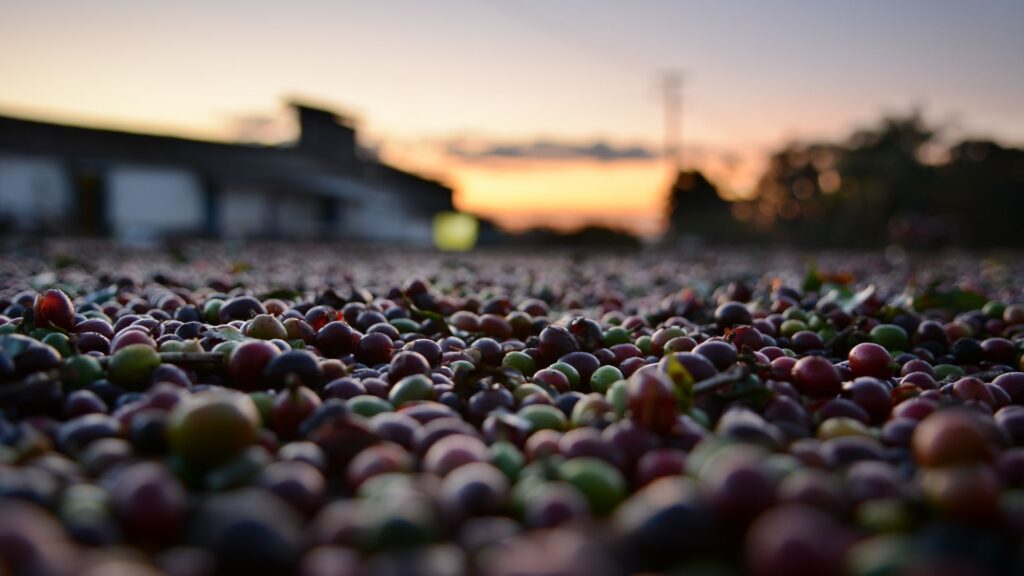
12. Take a day trip to the Ruta de Las Flores, one of the coolest activities from Santa Ana
We spent a few days on the Ruta de las Flores, but if you don’t have that much time, we recommend doing a day trip from Santa Ana. If you can time it with the weekend food markets in Juayua, even better!
The best time to visit the Ruta de las Flores is between November and February when the flowers are blooming. Even though there is still a lot to do in each of the towns on the Route, the flowers make the scenery that much more beautiful. The bus ride from Santa Ana to Juayua is only 1.5 hours long. You need to take Bus 238
On weekends, there are local food markets that take place in the towns. Juyua, the first stop from Santa Ana, is arguably the most popular one. The town is also a great place to set up camp if you want to explore the other towns in the area.
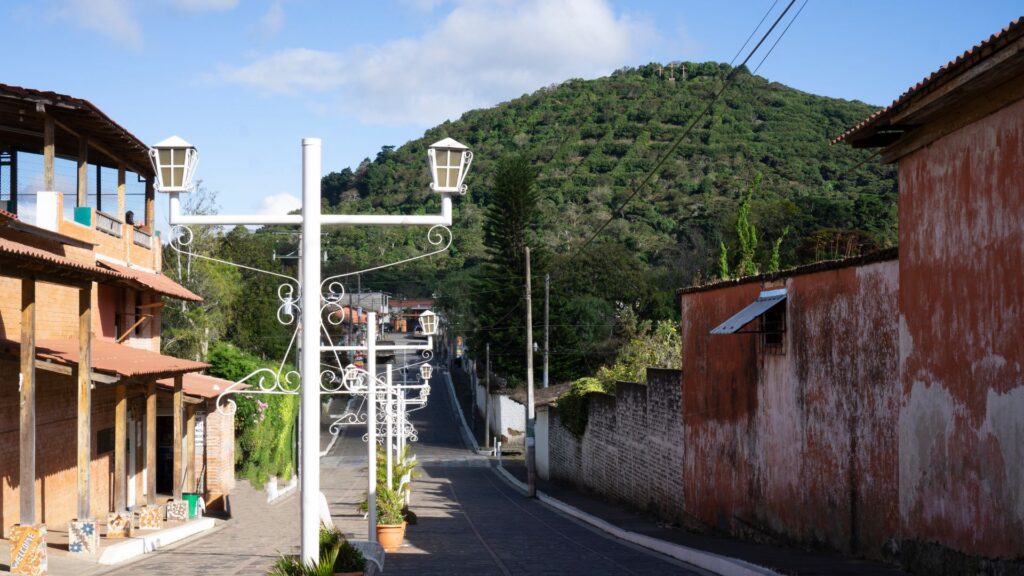
At the food markets, you can find all your traditional Salvadorian treats like pupusas, fried yuca and coffee, as well as other specialties. Plus, as with most food markets, it’s always fun to see locals and tourists interacting.
If you have the time, (as in, if you head there early enough), you can also do the 7 waterfalls hike in Juayua. We highly recommend hiring a local guide – We loved our experience with Elizabeth from Gaviotita Tours Aventura. Her and her brother took us on an amazing adventure to all 7 waterfalls, a water tunnel and a hike around. You can text or call on WhatsApp: +503 6113 7277.
You can also make a long day of the journey and also check out the other towns on the Ruta de las Flores. If you have a rental car, it’s the best way to get around from one place to the next. If not, the public buses run quite frequently from the main church in Juayua, heading to Ahuachapan. They cost a few cents, depending on where you hop on and off.
If you want to know more about the 7 Waterfalls hike, you can check our video out here:
13. Go on a day trip to the national parks around Santa Ana
If you want to get away from the hustle and bustle of Santa Ana, you’re in luck, because the city is surrounded by national parks and nature reserves. With a beautiful landscape and plenty of hikes to do, a quick escape to the national parks might be perfect.
Here are some of the nature reserves and national parks you can go to:
- Cerro Verde National Park: Apart from hiking Santa Ana Volcano, there are a few other hikes you can do at this park like Izalco Volcano. There’s also a nearby café called Crater Restaurant and Coffee Shop where you can hang out and enjoy the view on nice days. Note that this café is located a bit further from the trailhead. The bus back to Santa Ana only comes at 1 pm and 4 pm, so make sure you’re ready to take it back. This national park is about 2 hours away from Santa Ana.
- El Impossible National Park: Located near the border of Guatemala, about 2 hours away from Santa Ana, you have this national park that has incredible biodiversity, scenic landscapes, hikes, waterfalls and so much more.
- Montecristo Cloud Forest: Located 1.5 hours north of Santa Ana, on the borders of Honduras and Guatemala, you have this amazing cloud forest with lush vegetation. What’s really special about the cloud forest is that it’s actually a part of the Trifinio Fraternidad Biosphere Reserve – A UNESCO-designated park that spans across the 3 countries.
- Walter Thilo Deininger National Park: Named after a German naturalist, this park is located to the east of Santa Ana. Here, you can experience a tropical rainforest with a rich biodiversity.
Where to eat in El Salvador’s Santa Ana
There are plenty of good restaurants to choose from in Santa Ana, and there are also a ton of little food vendors on the streets. Here are a few places we enjoyed eating at:
La Ceiba: If you’re looking for the most famous and delicious pupusas in El Salvador Santa Ana, La Ceiba is the place to go. You’ll quickly understand why there are always a ton of people at this restaurant. The pupusas are good, the service is fast and the prices are low!
We tried a combination of different pupusas, from meat-filled to vegetarian and vegan, and they were all really good. You can easily have 3-5 pupusas here, depending on how hungry you are.
If you can, we recommend eating outside. It gets really hot and smoky inside.
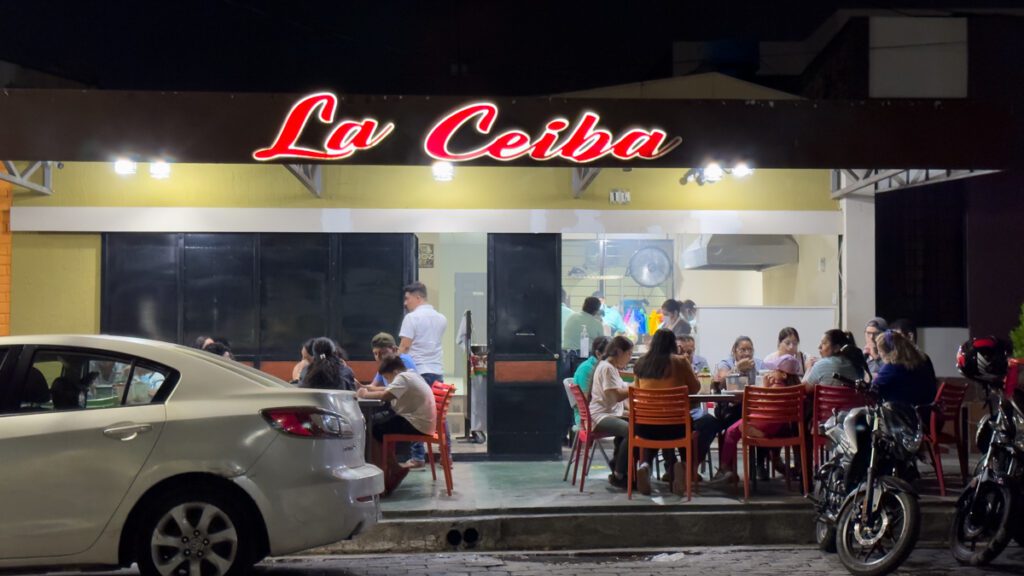
Any pupuseria: Sounds crazy, but seriously, we tried a bunch of different pupuserias and they each had a different mix of stuffings, and a different recipe for their pupusa. We loved them all. At less than $1 each, you can really indulge and try them all over the city.
Some of our favorite fillings were the traditional cheese and beans, a mix of meats, squash, loroco (a leafy green), onions, and just beans.
While we were in Santa Ana, we opted for an airbnb with a kitchen so we cooked most of our meals at home. Or we ate lunch on the road as we were exploring around the city. We did try a bunch of different pupuserias, as we mentioned, but can’t remember any of the names.
We will mention however, that it’s quite hard to be vegan in El Salvador, and Santa Ana. For the pupusas, you often have to ask that they remove the cheese from the stuffing. They do it, but they’re not happy about it!
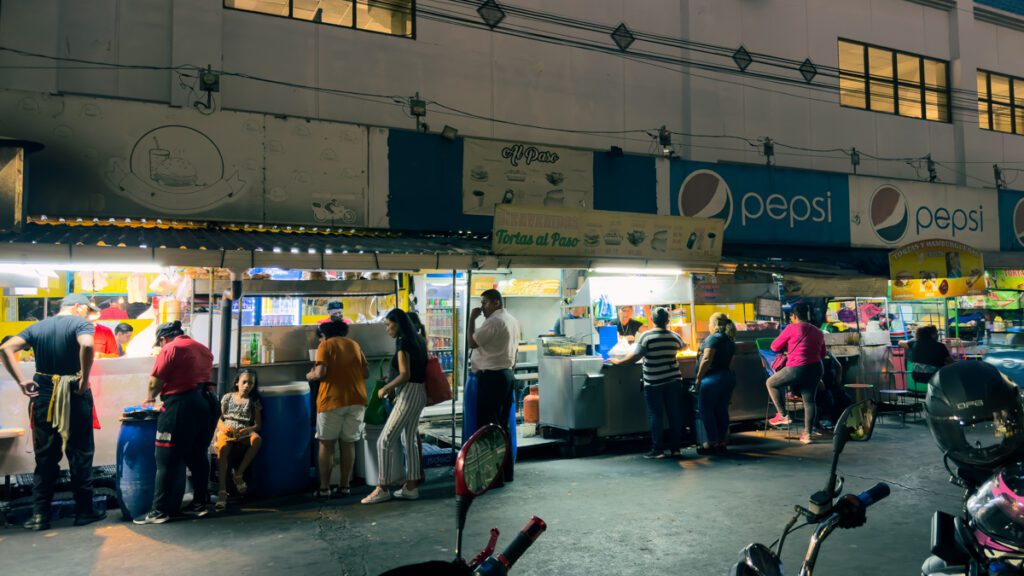
Where to stay in Santa Ana
There are plenty of options for where to stay in Santa Ana, from budget-friendly hostels to higher-end accommodations and everything in between. There’s really something for everyone!
We recommend staying close to the historic city center, as you’ll be closer to the best sights and restaurants in Santa Ana. However, since the city is bustling, you will hear lots of noises outside. If you want a quieter option, we stayed a bit on the outskirts of the city center, in this beautiful Airbnb.
Here are a few options for you. We tried to pick well-rated ones, that offered a great price-value ratio, and were close to the city center.
Hostels in Santa Ana: Hostel Casa Verde. Pool house Hostel. Velvet Centro Historico.
Mid-Range accommodations in Santa Ana: Casa Isabel. Edificio Kali Hotel.
High-end hotels in Santa Ana: Remfort Hotel. Casa Central Completa.
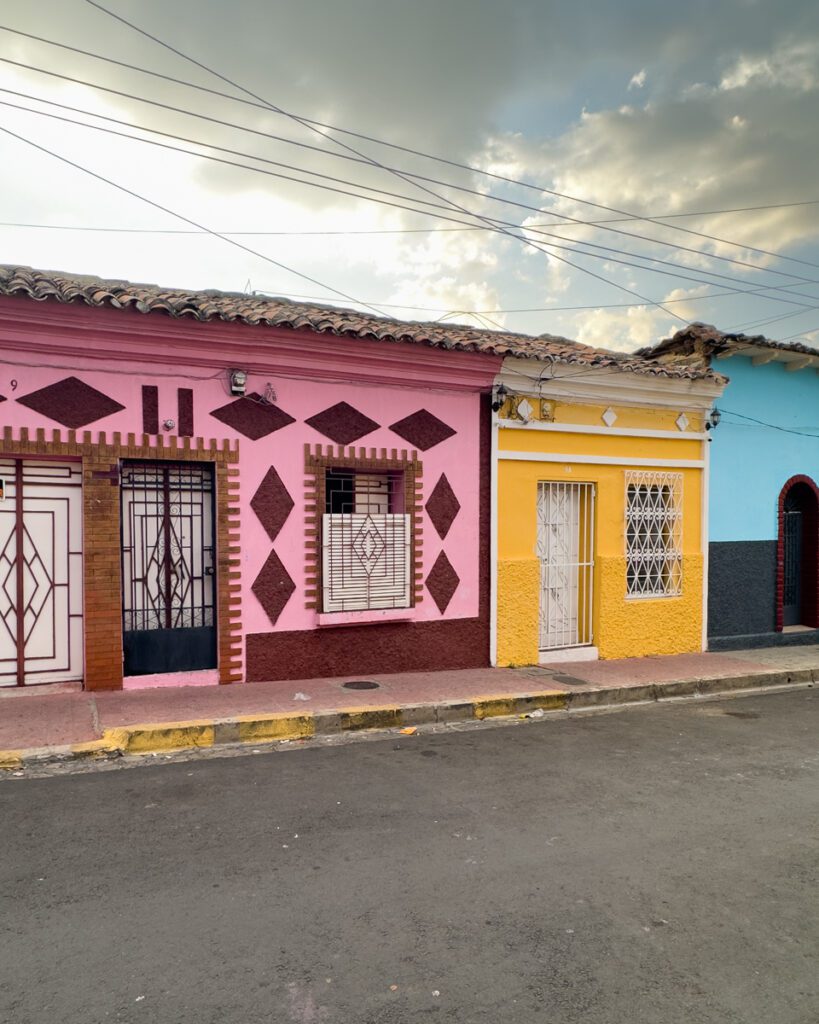
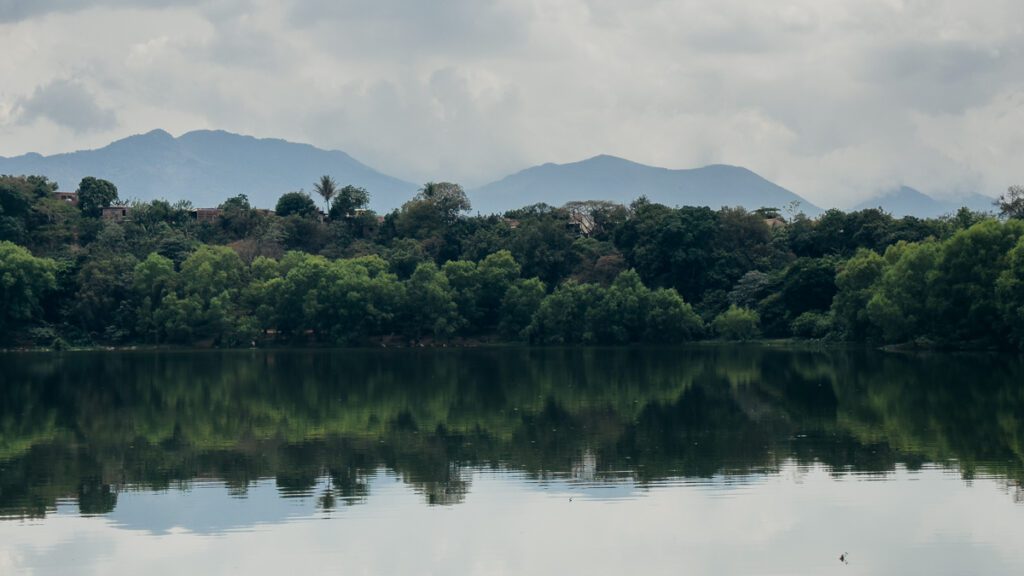
Things to know about visiting El Salvador’s Santa Ana
Before heading to Santa Ana and to discover the beauty of El Salvador, here are a few things you should know about the best time to visit, some important holidays, safety and more.
Important holidays in Santa Ana El Salvador
Santa Ana, and El Salvador for that matter, celebrate a bunch of national and local holidays. Some are cultural while others are religious. Some mean everything is closed, while others don’t.
Here is the list of holidays and festivals that take place in Santa Ana, El Salvador:
National holidays in El Salvador Santa Ana
- January 1: New Year’s day. Expect celebrations on December 31 too, including fireworks.
- March-April: One week of celebrations that takes place on the week leading up to Easter Sunday. Called Semana Santa, or holy week. It includes processions, religious ceremonies, and cultural events. Good Friday and Easter Sunday are particularly important. Expect closures, crowds and increased travel within the country.
- May 1: Labor Day. It’s a public holiday with events organized by labor unions and workers’ associations. Expect closures and difficulty traveling within the country.
- September 15: Independence day. To mark El Salvador’s independence from Spanish rule in 1821. Expect closures, and festivities like parades, patriotic events and cultural activities.
- November 1 & 2: All Saints’ Day and All Souls’ Day. Similar to Day of the Dead celebrations in Mexico. Families visit cemeteries to honor and remember their departed loved ones.
- December 25: Christmas. Widely celebrated in Santa Ana and all around El Salvador. Festivities include religious ceremonies, feasts, and gatherings with family and friends. Expect closures and increased prices. Traveling around the country may be slower and more difficult too.
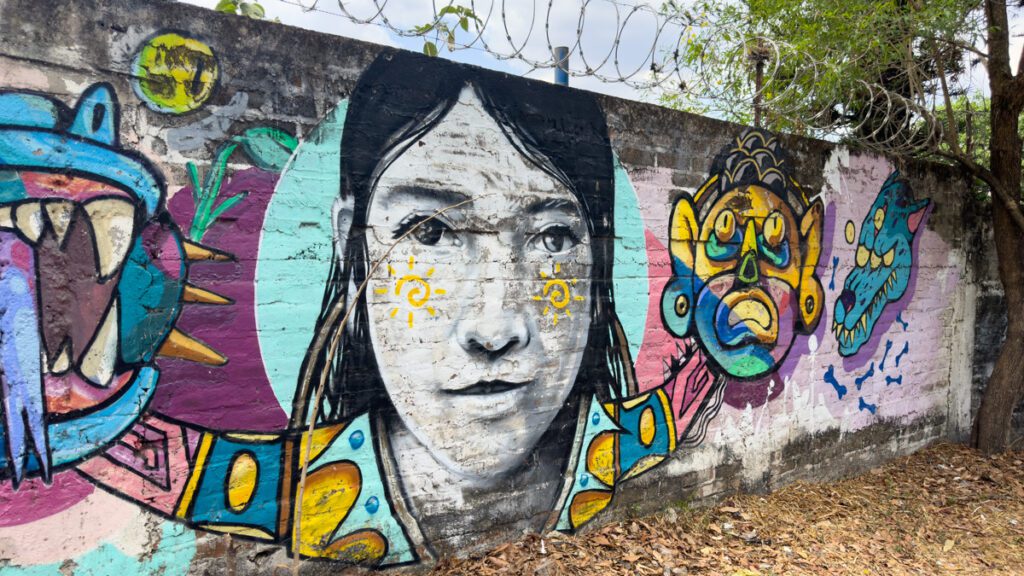
Local Festivals and Celebrations in Santa Ana
There are also many festivals and celebrations that take place not only in Santa Ana, but also in El Salvador. Here are a few of them:
- July 17 to 26: Feast of Saint Anne (or Fiesta de Santa Ana) or July festivities. For about 10 days, usually around July 17 to 26, the city celebrates its patron saint with religious processions, cultural events, and festivities. This also includes parades, food festivals and a lot more.
- August 1: Youth Day recognizes the contributions and aspirations of young people in El Salvador.
The best time to visit Santa Ana in El Salvador
There are a few good months in the year that are the perfect times to visit Santa Ana. Depending on what you’re looking to do, this period may vary for you. So here are a few things you should know about when to visit El Salvador’s Santa Ana.
- The Dry Season runs from November to April. Best for those who love outdoor activities like hiking and exploring archaeological sites since the weather will be dry and sunny. For coffee lovers, this is a great time to go as the harvest happens from November to February when you can visit plantations at their most active. However, you can expect more tourists (although this is El Salvador, so there aren’t crazy amounts of tourists) and higher prices. Make sure you book your accommodations ahead of time.
- The Rainy Season is from May to October. You can expect some sun but bouts of heavy rain as well. The landscapes will be green and lush, and you’ll have fewer crowds around which means better pricing. However, some places and hikes might not be accessible due to heavy rain. Just note that June to November is when you can expect heavier rain and more weather disturbances as it’s hurricane season in the Atlantic. Although El Salvador is not directly affected by hurricanes, it can still get heavy rain due to it.
- Semana Santa is the week before Easter Sunday. For those who want to experience traditional culture, it’s a great time to go. However, there will be more crowds, prices are higher and availabilities might be harder to come by.
- City Festivals in mid to end July are also a great time to discover the culture in Santa Ana.

Is Santa Ana El Salvador safe?
El Salvador still has a bad reputation for its crime rate. Although it does have a shady past, that is quickly changing. The country has opened itself up to tourism and the government and police entities are working hard to make it a safe country. Santa Ana is pretty safe overall, but you should still exercise caution.
While we were there, we didn’t have any issues with safety. We thought Santa Ana was very safe, but we stayed in the tourist areas. We walked around, as much in the day as at night, and didn’t have issues. It’s important to note that we did take precautions. We were often with friends and didn’t go around alone at night. We didn’t flash our belongings around and we avoided sketchy areas.
We took the local buses and walked around a lot. Overall, we felt like the people we spoke to (in Spanish) were very nice and welcoming. We had a great experience going around in Santa Ana, and El Salvador.
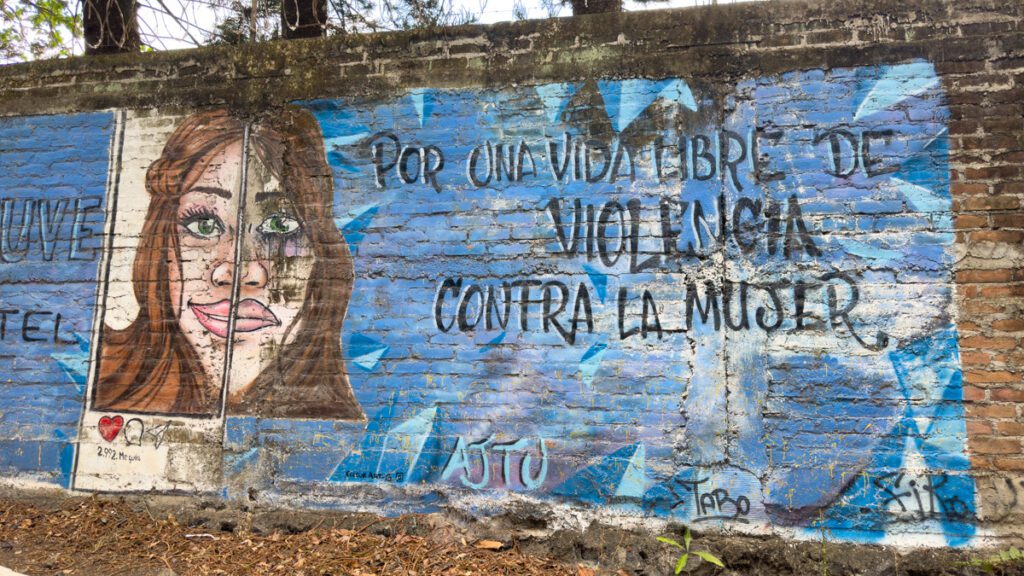
How to get to Santa Ana
Getting to Santa Ana is fairly easy, no matter where you choose to come from. We were in Guatemala before coming here, and we simply took a shuttle to get here. You can also get to the city by bus, air or other means of transportation.
Either way, make sure you have a valid passport, and that you have any other travel documents you may need. Also, note that since 2005, El Salvador has been a signatory to the CENTRAL AMERICA (CA-4) BORDER CONTROL AGREEMENT. This means that a single Central American visa is valid for foreign nationals to move freely across the borders of the Republics of EL SALVADOR, HONDURAS, GUATEMALA, AND NICARAGUA. However, you should know that this visa is valid for a total of 90 days.
Getting to Santa Ana by air
There’s only one airport in El Salvador that offers international flights: Monseñor Óscar Arnulfo Romero International Airport (Airport code: SAL). It’s located in San Salvador which is about 1.5 hours away from Santa Ana.
Once you arrive at the airport, you can either take a taxi or a shuttle to get into Santa Ana. They also have rental cars available, if you choose to drive around the country and explore it that way.
Getting to Santa Ana from San Salvador
Getting from San Salvador to Santa Ana is actually quite simple. You can either take a shuttle or an Uber. You can also choose to take the local bus.
It’s good to note that the local buses in El Salvador go pretty much everywhere in the country. You can easily get around for really cheap! We found the buses to be quite safe, but as always, you should be cautious when traveling with your belongings.
To get to Santa Ana from San Salvador, head to Terminal de Occidente and take bus #201 all the way to Santa Ana. There are regular buses and especial ones. The latter are the nice red-colored TUDO buses. They have AC and don’t really make any stops. It will be a faster ride than the local buses.
Getting from Santa Ana beaches of El Salvador
El Salvador is home to some of the most beautiful beaches in Central America that are well worth exploring, especially if you want to learn how to surf. We spent 2 weeks on the Pacific Coast of El Salvador and loved it. The vibes are great, the food is amazing and the people are laid-back and sweet.
If you want to go to the amazing beaches of El Salvador from Santa Ana, or from Santa Ana to the beaches, you can either hire a shuttle, rent a car or take the bus. We opted for the buses while we were in El Salvador, they are well-connected and cheap.
To get from Santa Ana to El Tunco (or La Libertad), head to the Santa Ana Metrocentre. There, hop on 201 or grab a TUDO bus to get to San Salvador, to the Estación Ceiba de Guadalupe. This is a stop on the highway where you have many other buses traveling to different parts of El Salvador. Cross the road from where you got off the bus. Wait for a 102A bus going to Sunzal. Buses come every 20 minutes, and take around one hour to reach El Tunco.
Getting to Santa Ana from Guatemala
This is the route we took. We left Antigua in the morning and arrived in Santa Ana in the afternoon. The service we used was door-to-door and cost $40 USD per person. The pick-up was between 10-11 am and we arrived around 3-4 pm. Sometimes, the route can take longer, as it depends on how busy the border gets. We got quite lucky.
Since there was a border crossing, we didn’t want to take a chance. And as creators, we have a lot of gear with us, so figured the best way for us to get from Antigua to Santa Ana was to take a shuttle. It was easy and overall, we would recommend this option if you want a painless travel experience.
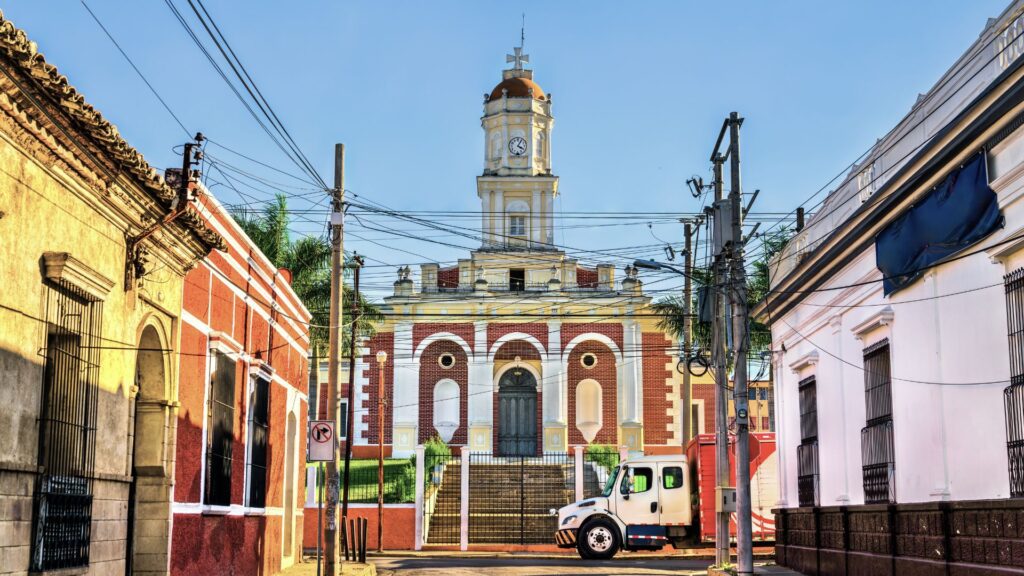
How to get around Santa Ana
Taking the local transportation and Uber is probably the best way to get around Santa Ana. In fact, Uber is very practical and cheap, so if you want to get around quickly, Uber is a great way to do it, especially if you’re traveling as part of a group, like we were.
There’s also a great website called Centro Coasting that has details about the bus routes in and around Santa Ana. It’s often updated with more recent information. However, some of the details are not always up to date, so if you have the time, we recommend you find out the routes and details before you go on your journey. This website is great to use if you’re trying to take the local buses to get around Santa Ana.
What currency is used in El Salvador & Santa Ana?
El Salvador uses both Bitcoin and USD as a national currency. You’ll notice Bitcoin ATMs all over the city and the country. However, we recommend sticking to the US dollar. It’s accepted everywhere, and it’s much easier to get it than Bitcoin.
If you want to exchange your money into USD in El Salvador, or any other country in Central America, you will need to have your passport with you. They ask for this as a way to reduce fraud and crime.
What language is spoken in Santa Ana?
People in El Salvador, and in Santa Ana, mainly speak Spanish. However, because of the increase in tourism, there are more people that speak English. Don’t expect super clean and clear English. But most speak enough to get by.
We do recommend you try and pick up some Spanish before getting to El Salvador. Not only will it make your trip easier, but it’s also a great way to connect with locals.
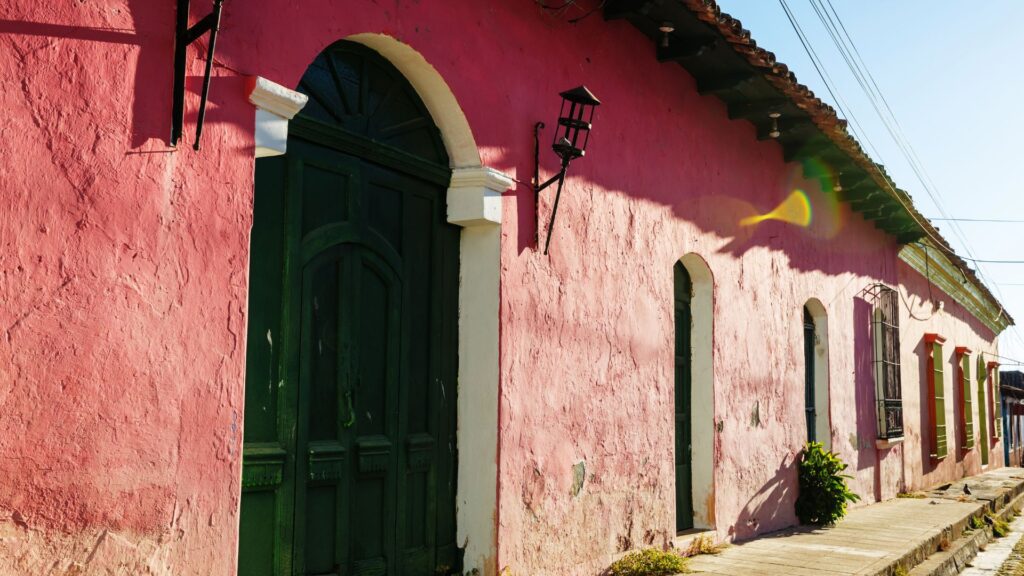
Top 13 things to do in El Salvador’s Santa Ana
There you have it. Everything you need to know about having a great trip to Santa Ana El Salvador. It’s a beautiful city to explore and there’s tons to do around here.
As a reminder, here are the best things to do in Santa Ana:
- Check out the Cathedral of Santa Ana
- Hike the Ilamatepec Volcano
- Explore Coatepeque Lake
- Experience the local markets
- Wander around the historic Downtown
- Check out the Santa Ana National Theatre
- Visit the Mariano Mendez School of Fine Arts
- Explore Joya de Cerén Archaeological Site
- Visit Tazumal Archaeological Site
- Relax in Thermal Springs
- Take a Coffee Tour around Santa Ana
- Take a day trip to the Ruta de Las Flores
- Visit the national parks around Santa Ana
Let us know in the comments what you’re most looking forward to doing while you’re in Santa Ana, El Salvador. Are there any other activities or attractions we should be adding to our list?
Thank you so much for reading the article all the way through!
We put a lot of time and effort into the content we create. Please like, comment and share – every action on your part helps us out tremendously and is very appreciated.
You can also help us by pinning this article for others to find.
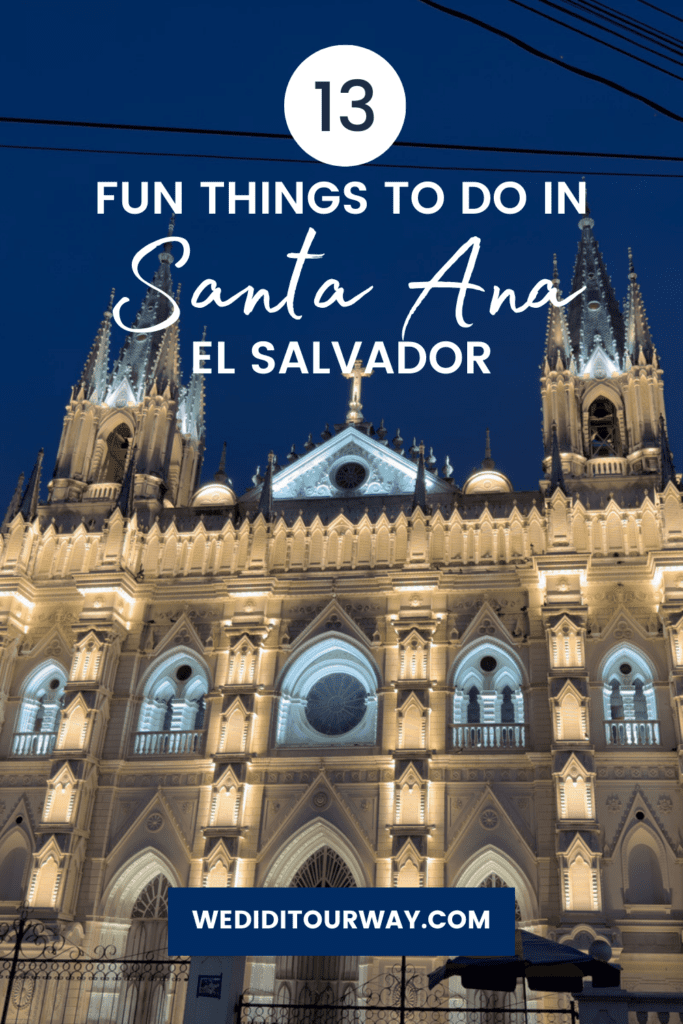
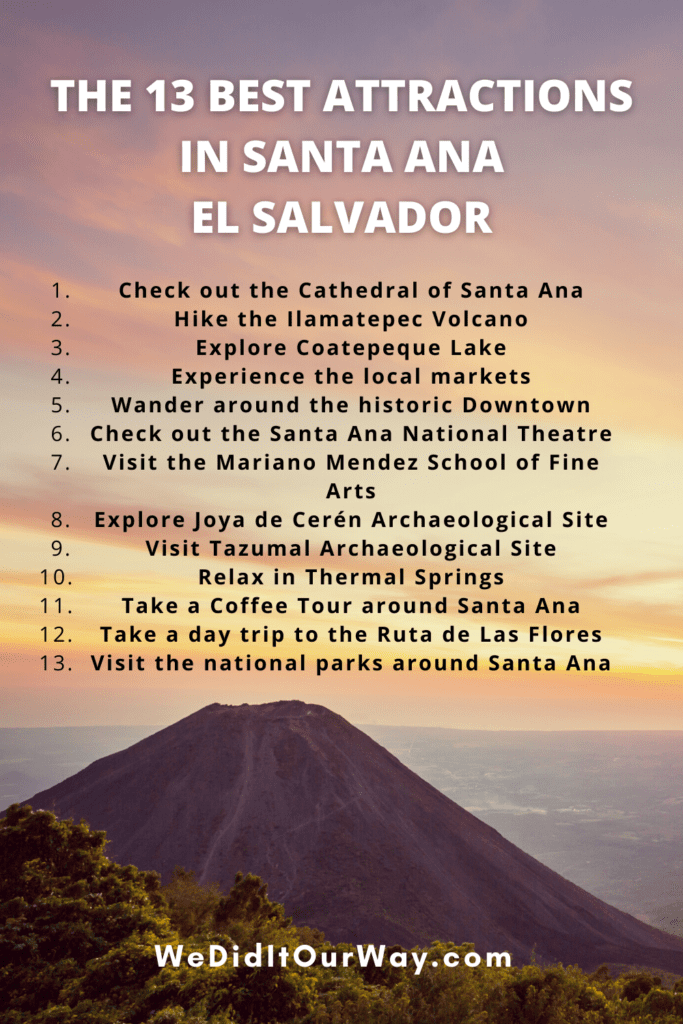
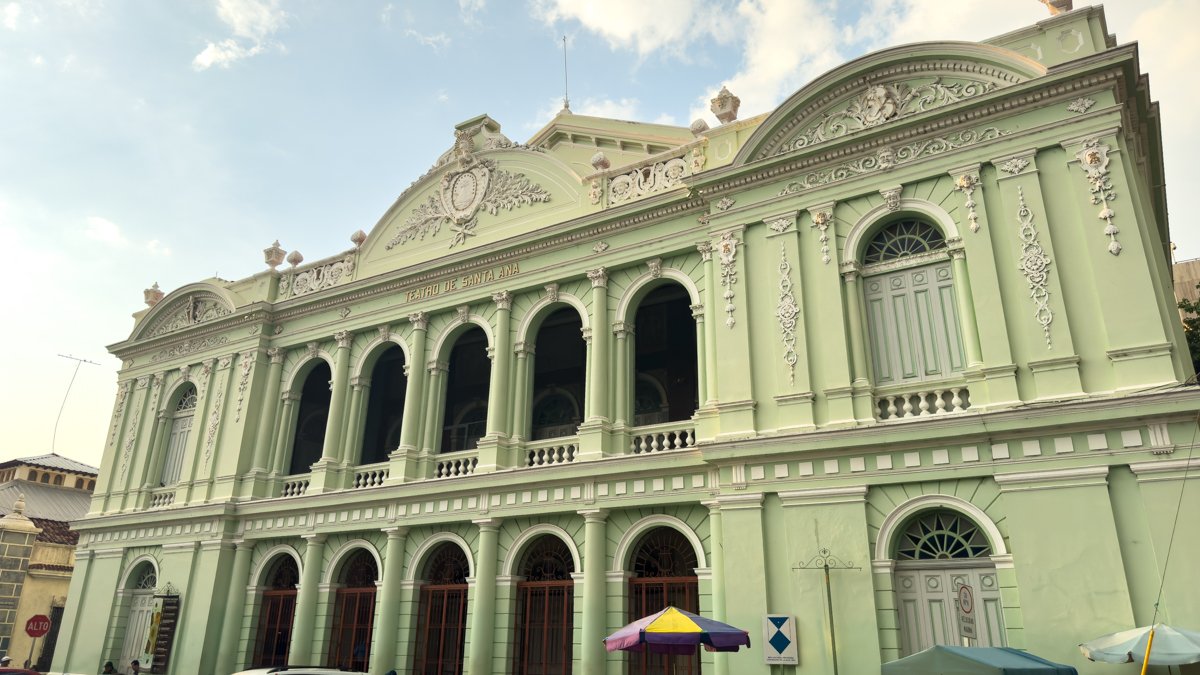
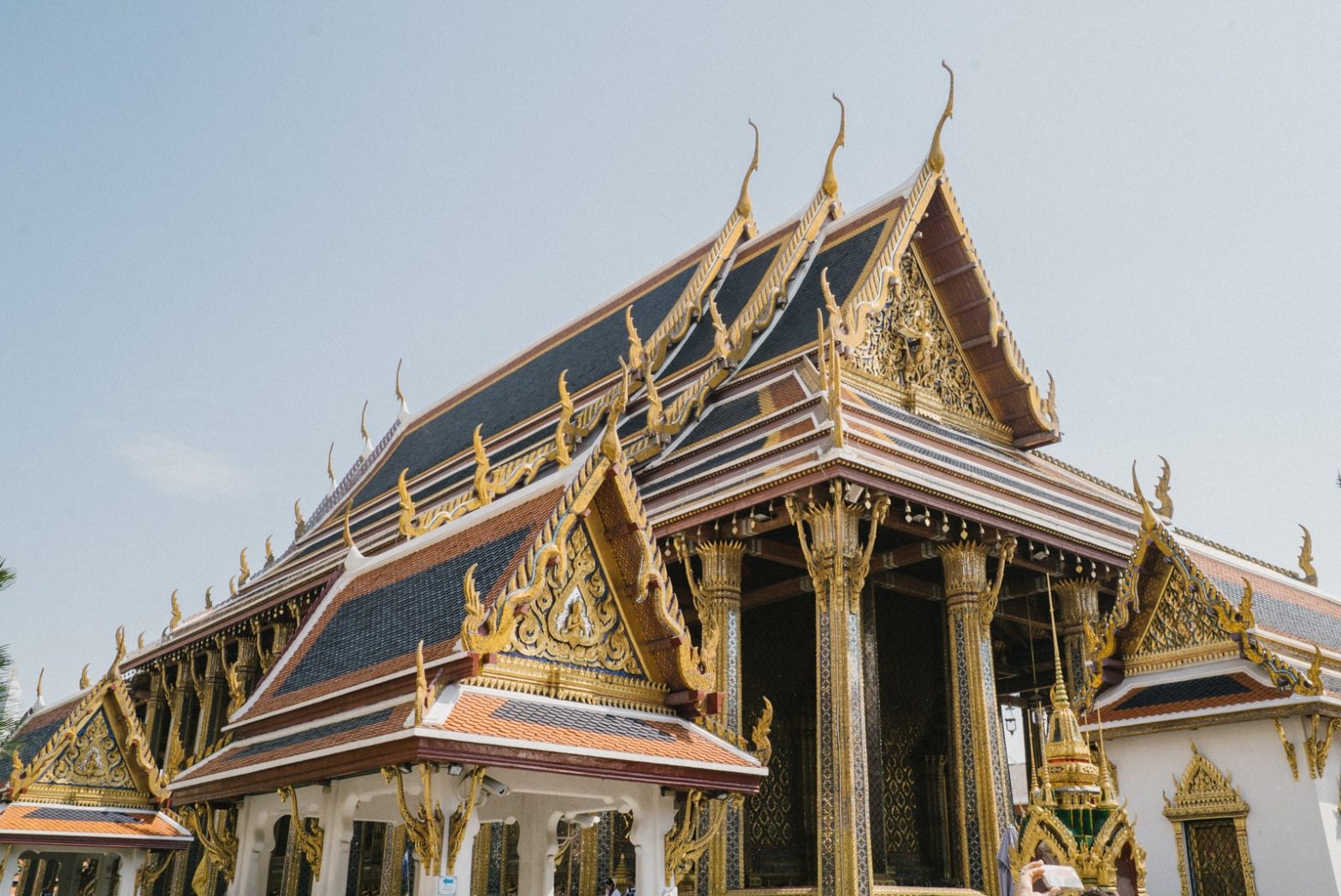
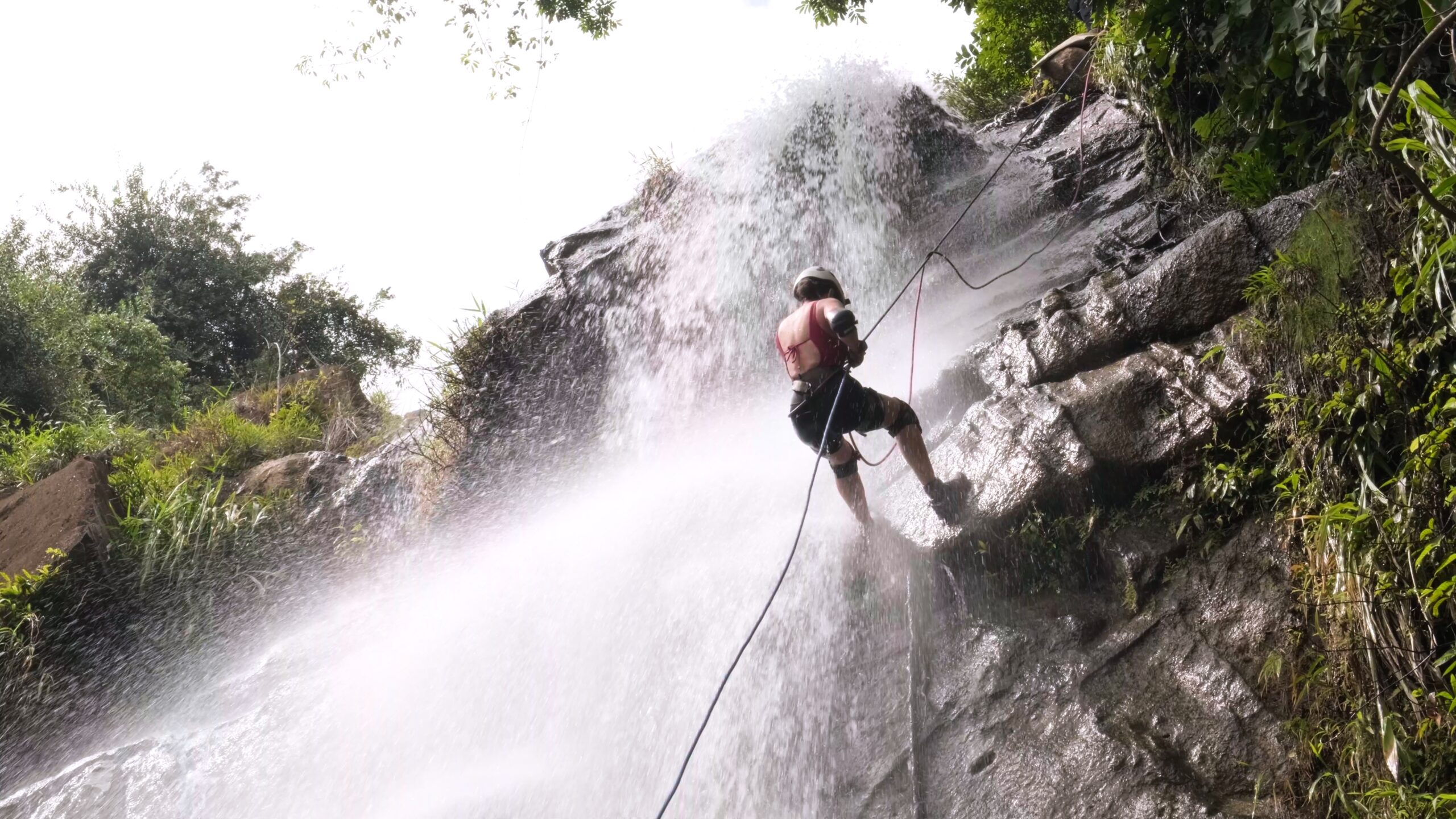
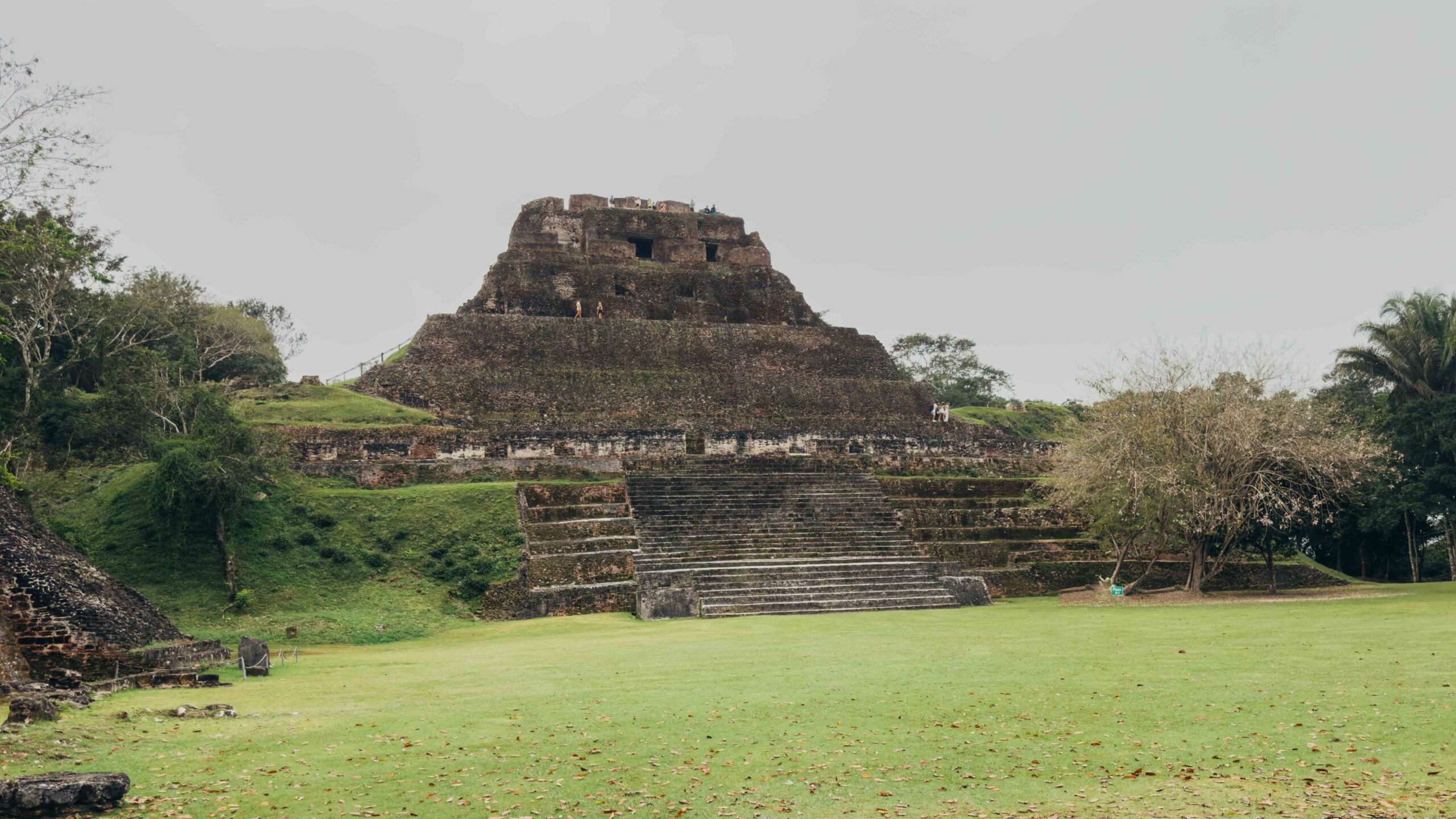
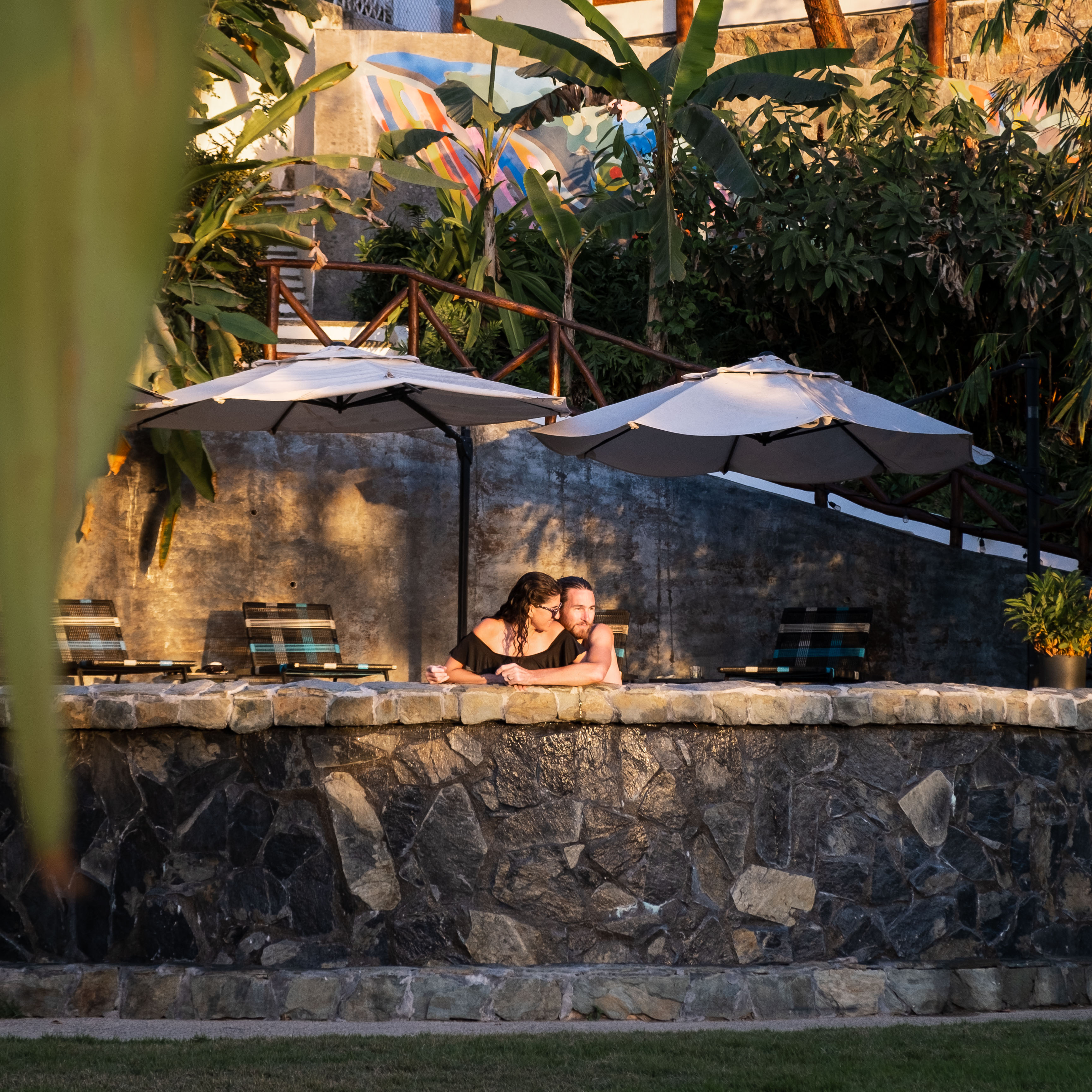


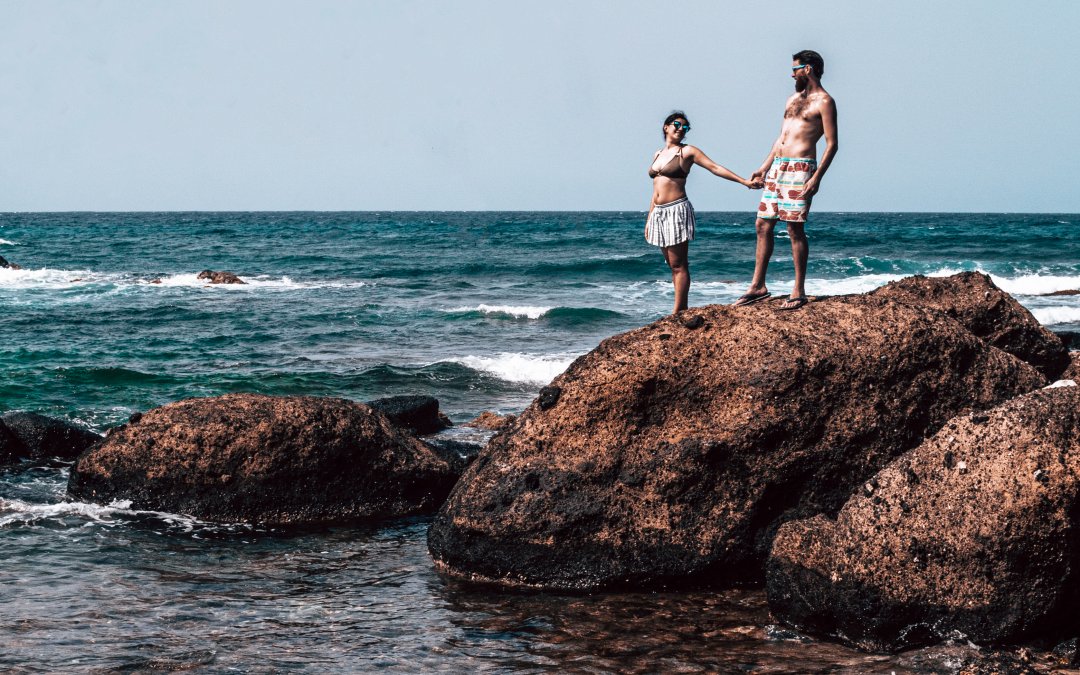
0 Comments